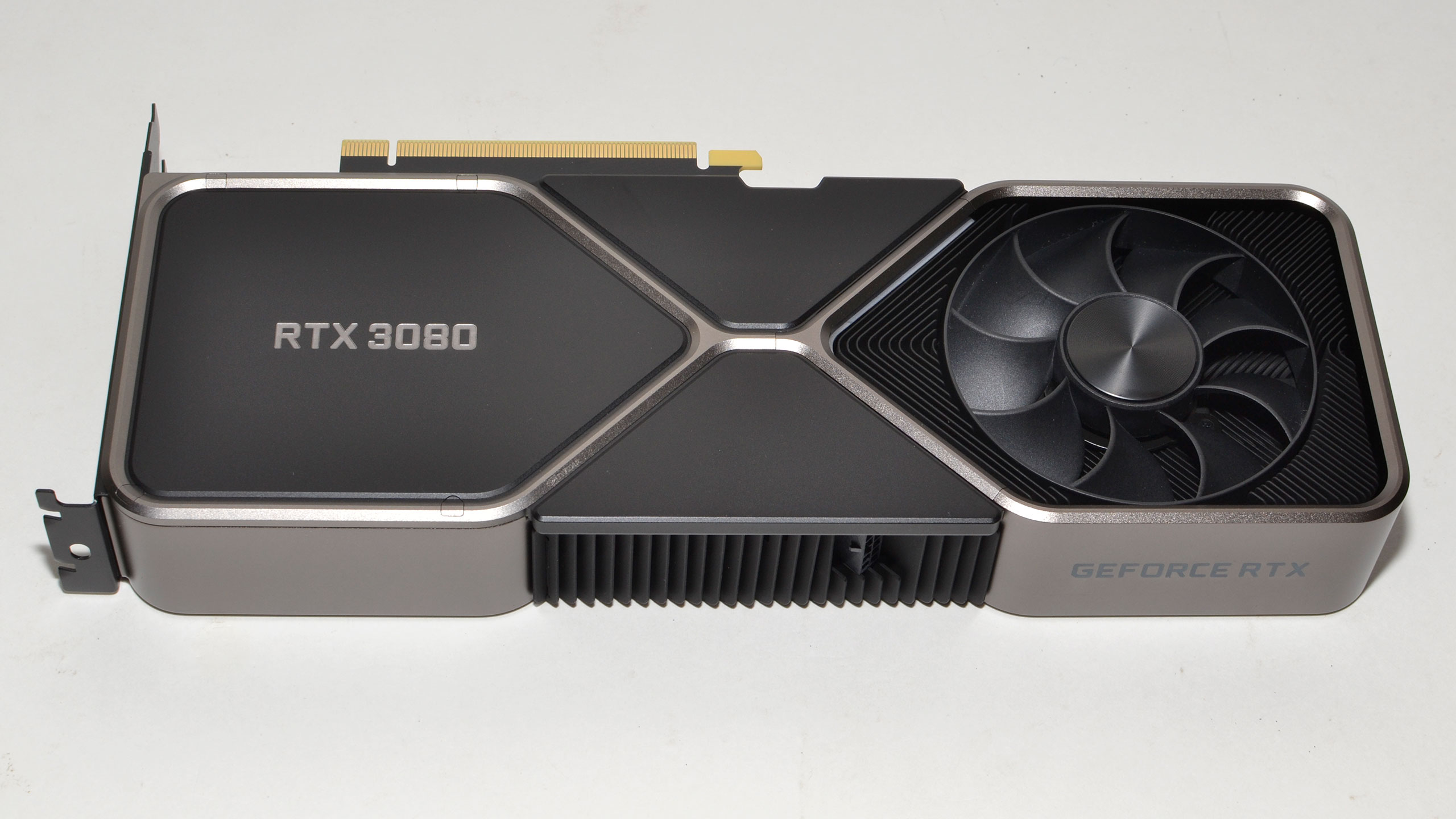Why you can trust Tom's Hardware
For each of the games we tested, we have results at 1080p, 1440p, and 4K. However, we're not going to show or discuss all the 1080p data because the RTX 3080 most definitely isn't designed as a 1080p gaming card. Unless you're running ray tracing effects at maximum quality, but then you should probably use DLSS in performance mode to upscale to 4K. We'll start with the 4K results first, at ultra and medium settings, before wrapping up with the 1440p charts and the overall 1080p performance charts.
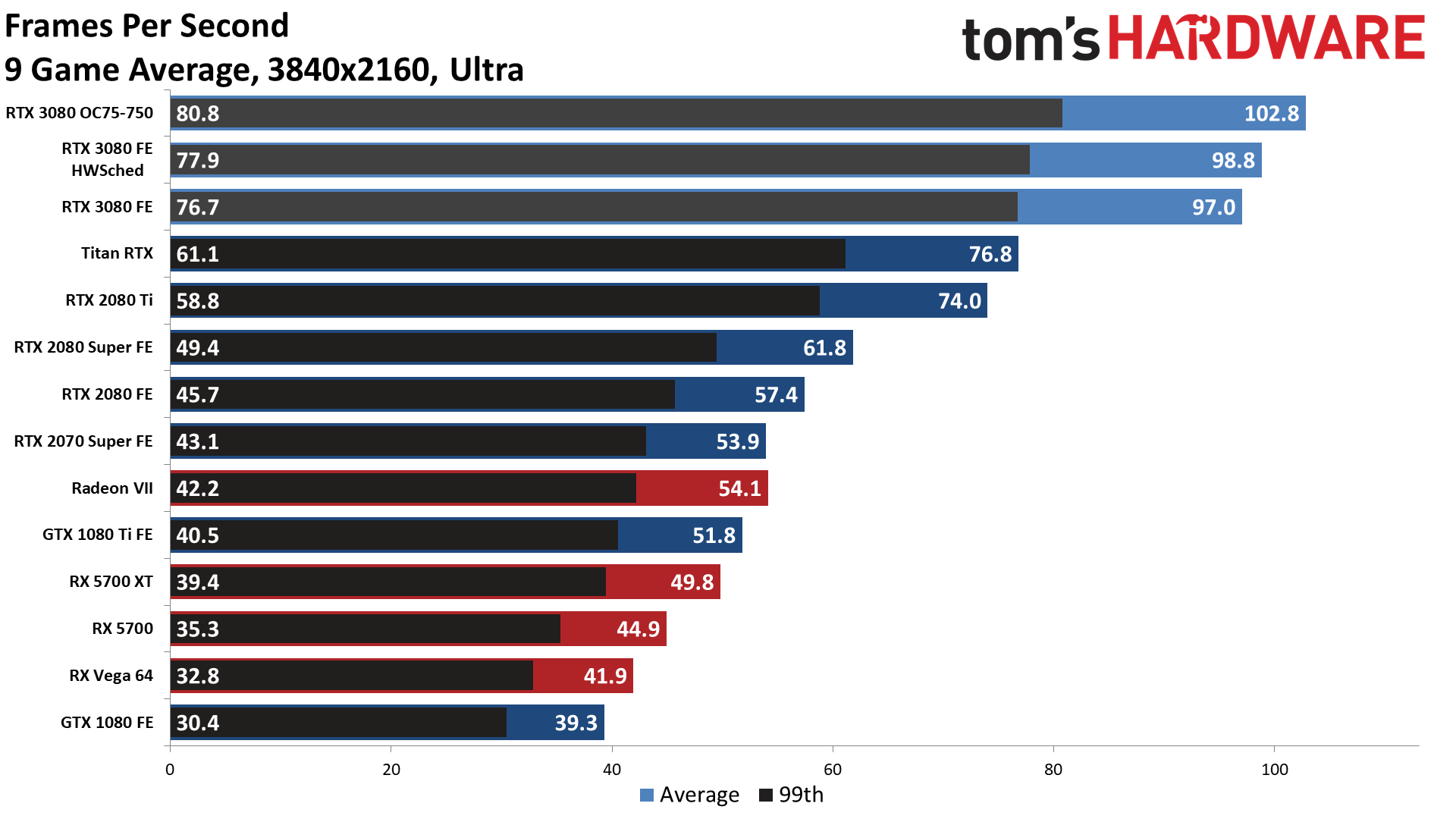
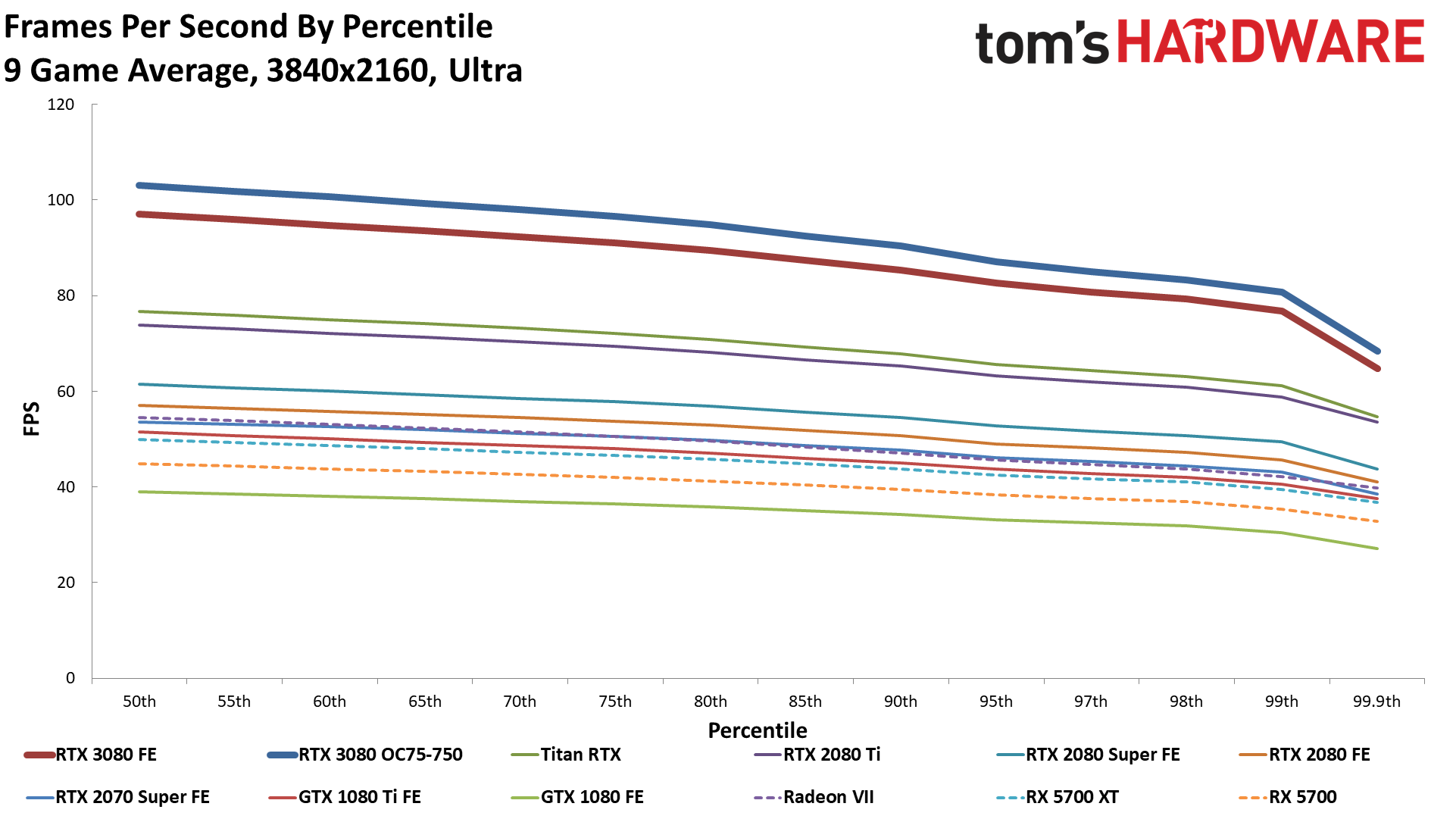
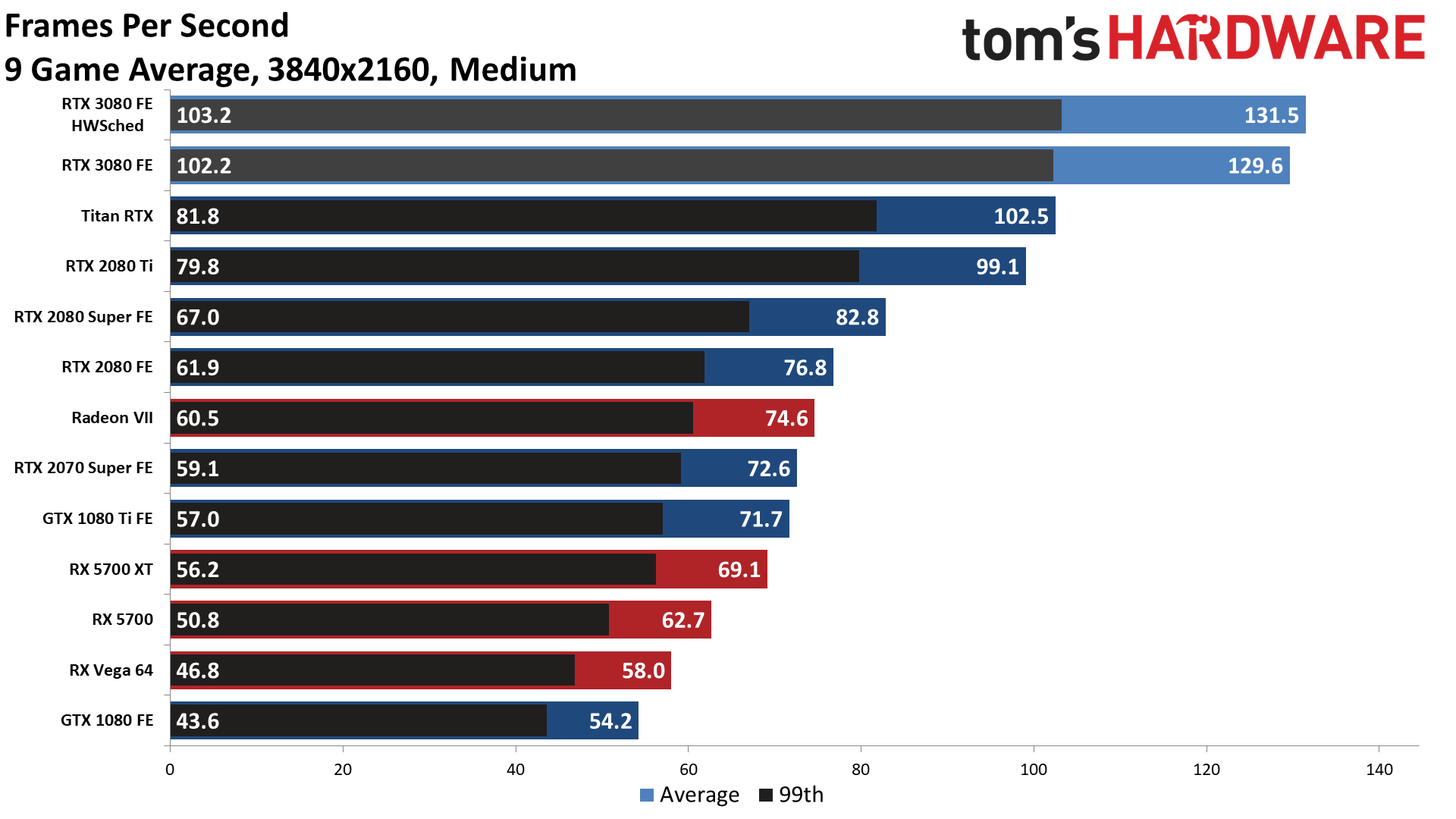
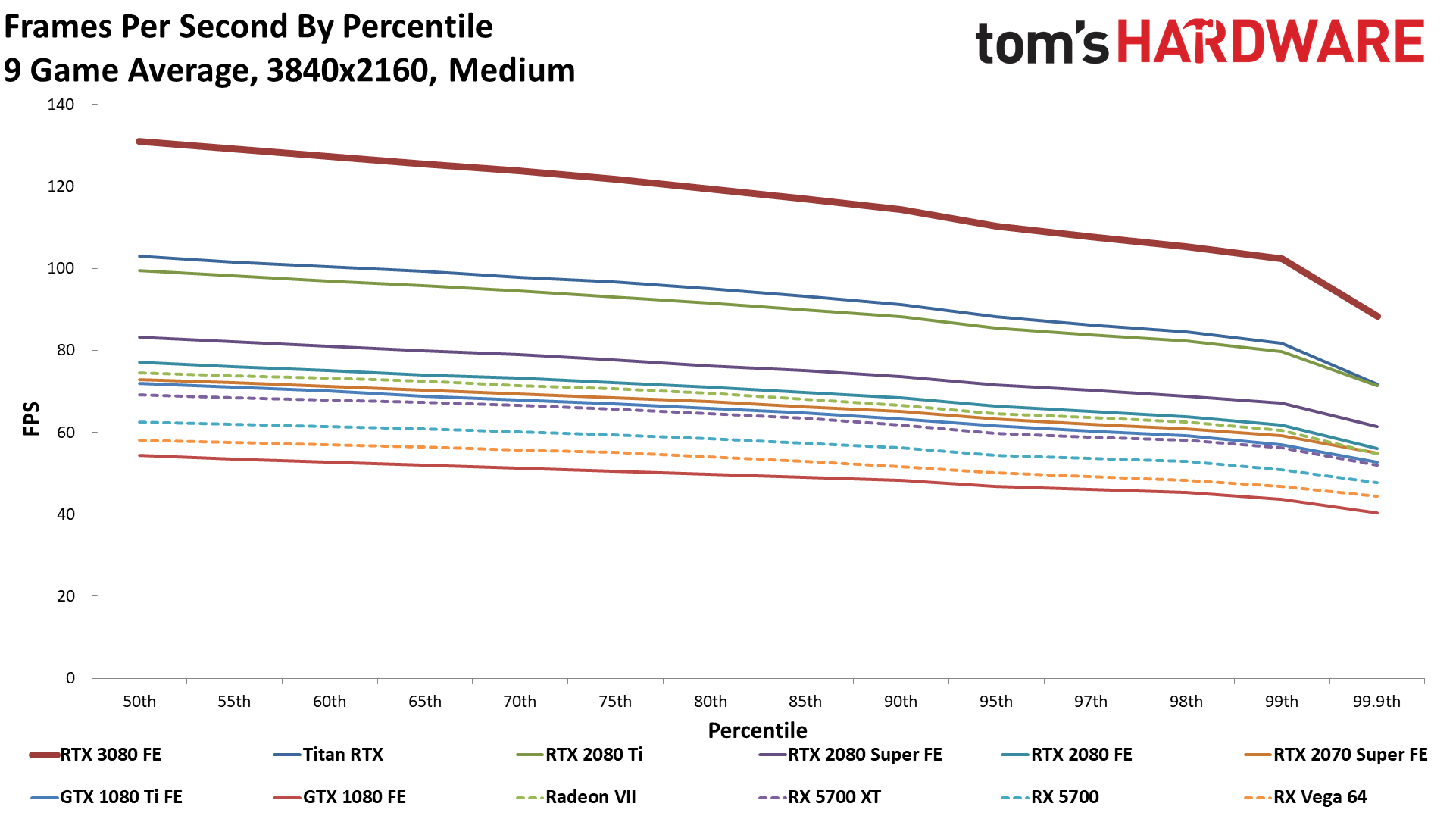
Starting at the high-level overview where we average performance across all nine games in our test suite, this is a good view of what's to come. The RTX 3080 Founders Edition blew away the competition: It's not even close. It ended up 27% faster than the Titan RTX, 32% faster than the RTX 2080 Ti, 57% faster than the RTX 2080 Super it replaces at the $700 price point, and 69% faster than the RTX 2080 FE. If you're hanging on to a 10-series Nvidia card, the 3080 also beat the 1080 Ti by 87% and ended up nearly 150% faster than the GTX 1080 FE.
AMD's best showing at 4K ultra is still the Radeon VII, which the 3080 beats by 79% — though, of course, we're more interested in seeing how Big Navi compares. The RTX 3080 also beat the RX 5700 XT by 95% overall. AMD has talked about 50% better performance-per-watt for Navi 2x, which might be enough to catch the RTX 3080 (depending on how AMD gets that 50% boost — a 300W card that's 50% more efficient should do it).
Perhaps more importantly, the RTX 3080 is the first graphics card we've tested that manages to break 60 fps in every game in our current test suite at 4K ultra, averaging nearly 100 fps overall. That doesn't mean minimum fps stayed above 60, and sometimes it dropped into the 40s, but it's the best result we've seen by a fairly large margin.
Stepping down to 4K medium settings, the RTX 3080 maintains its pole position, and the margin of victory was basically unchanged. It's still 26% faster than the Titan RTX (at less than one third the price) and 69% faster than the RTX 2080 FE. That's the great thing about 4K: Even at medium quality, it's still typically GPU bottlenecked (unless you're using a very slow CPU).
As we'll see below, individual games will vary a bit from these margins, and some still appear to encounter a bit of CPU bottlenecking, but these overall averages tell the real story.
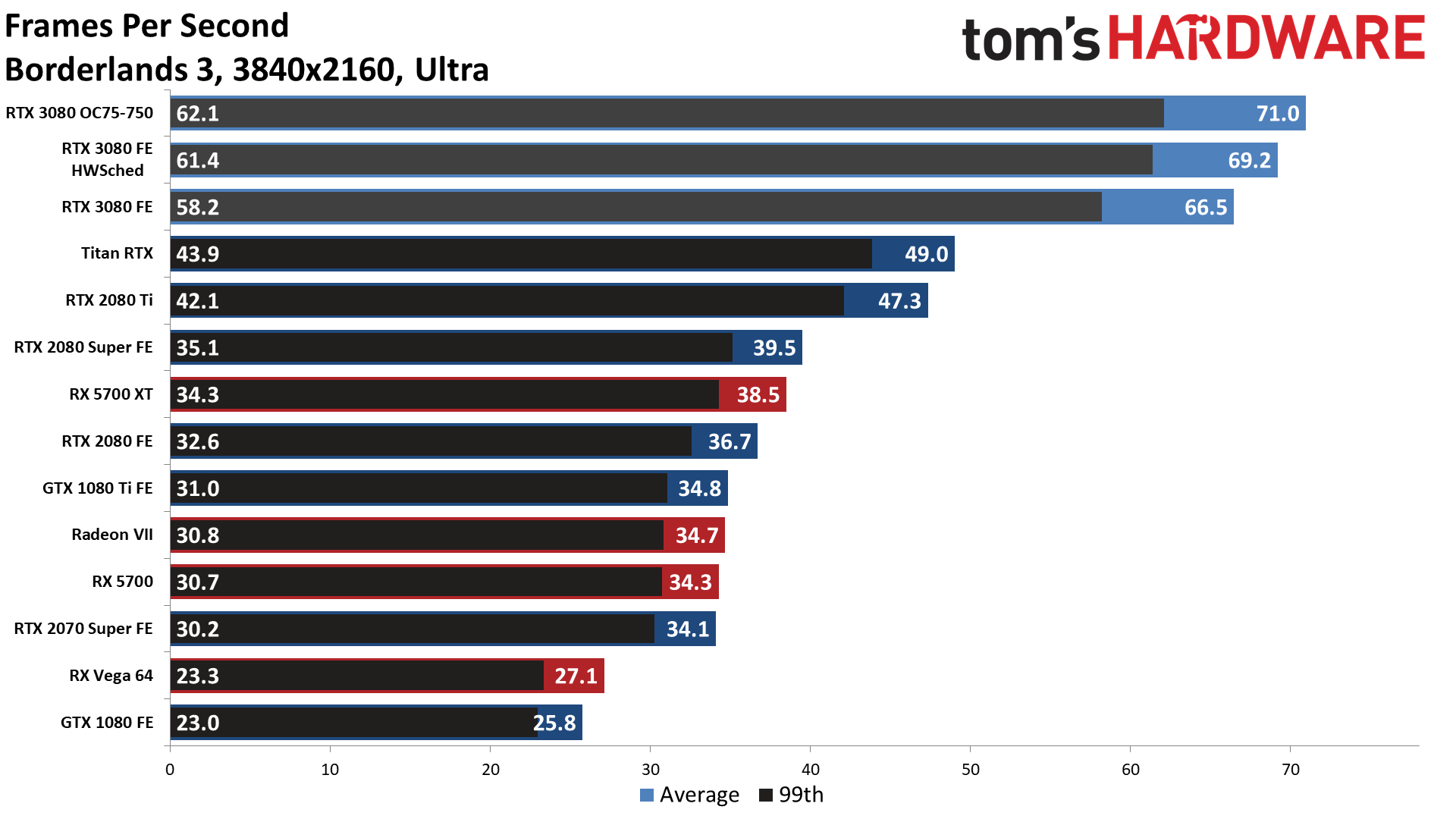
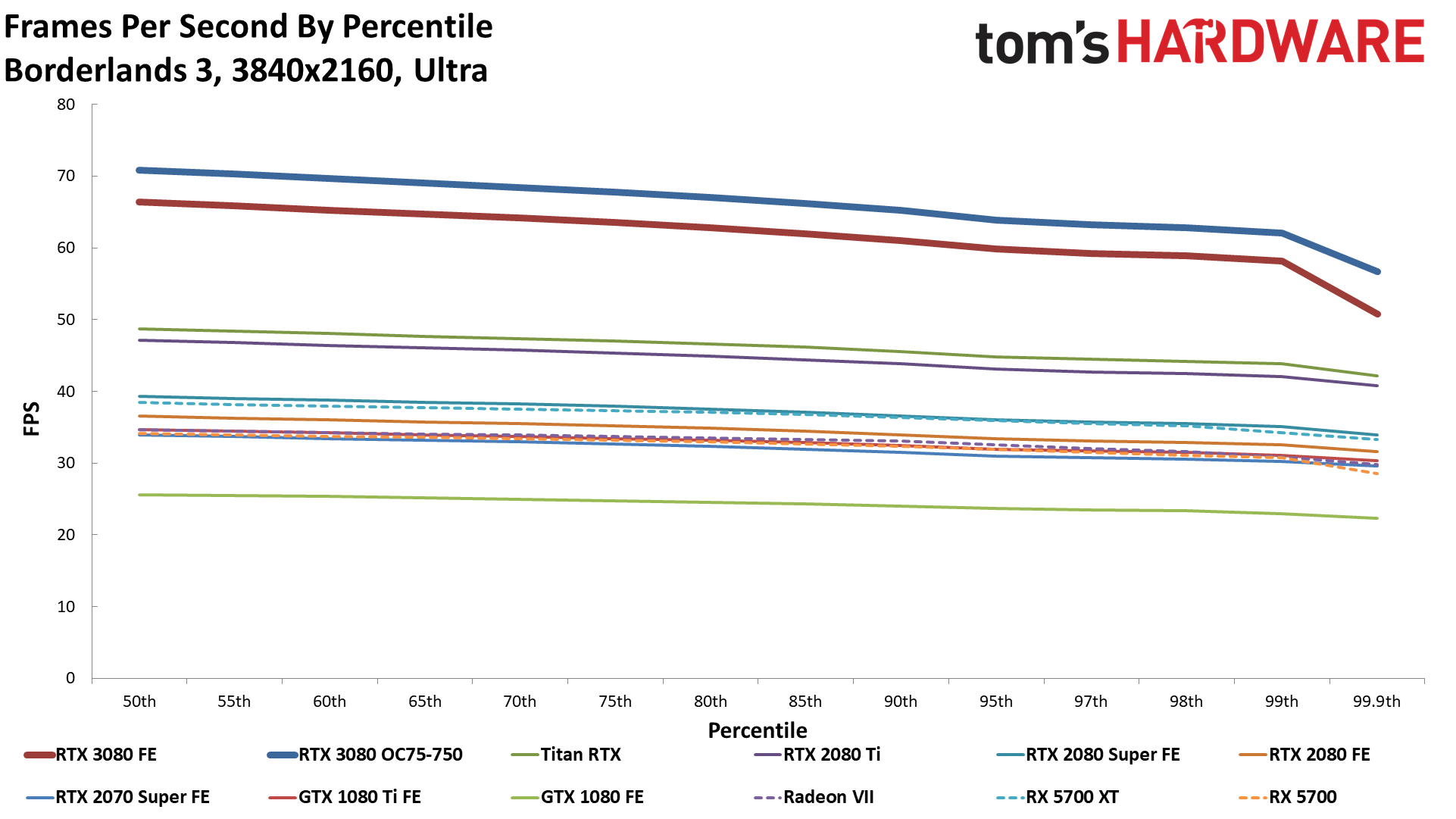
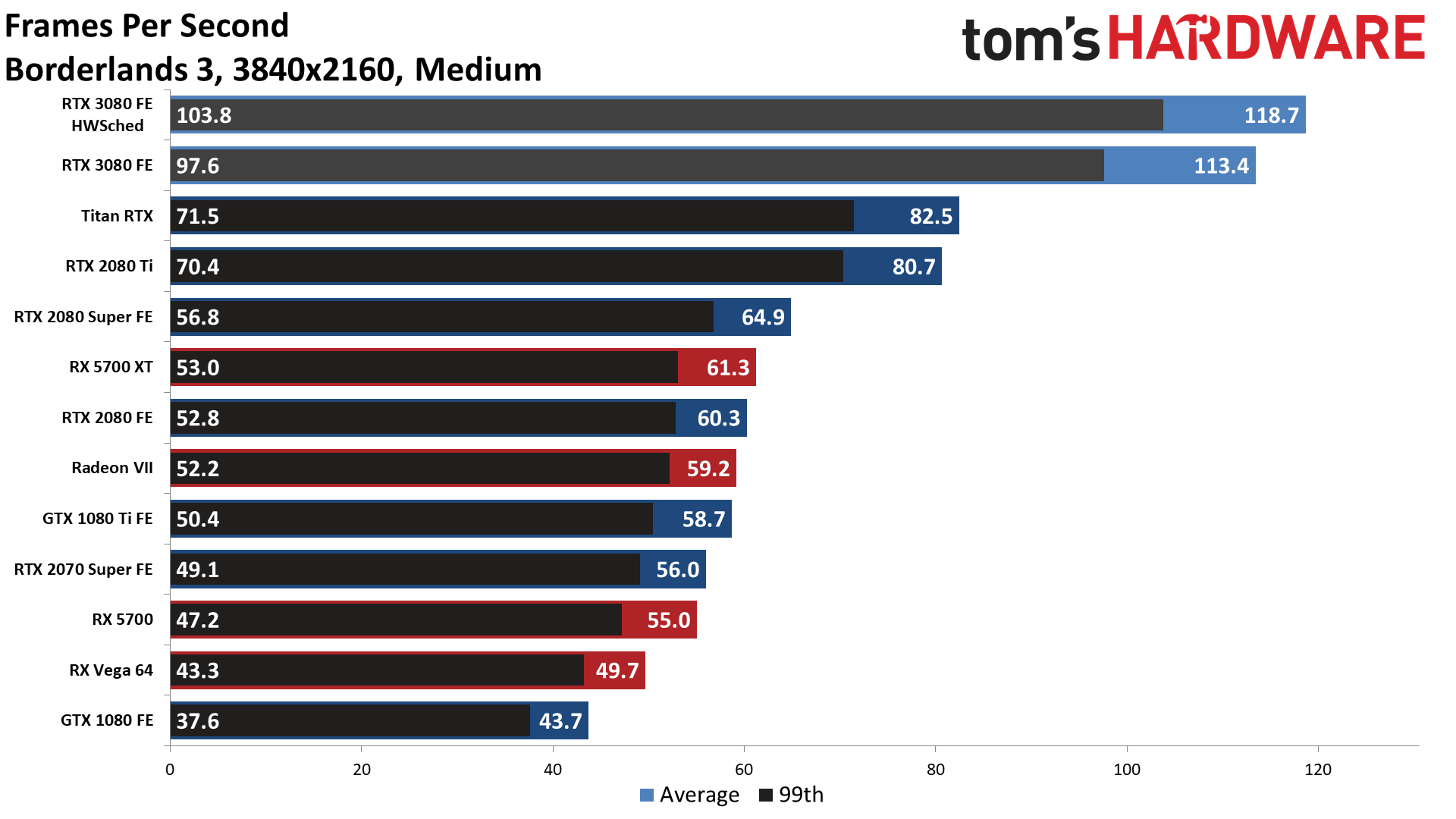
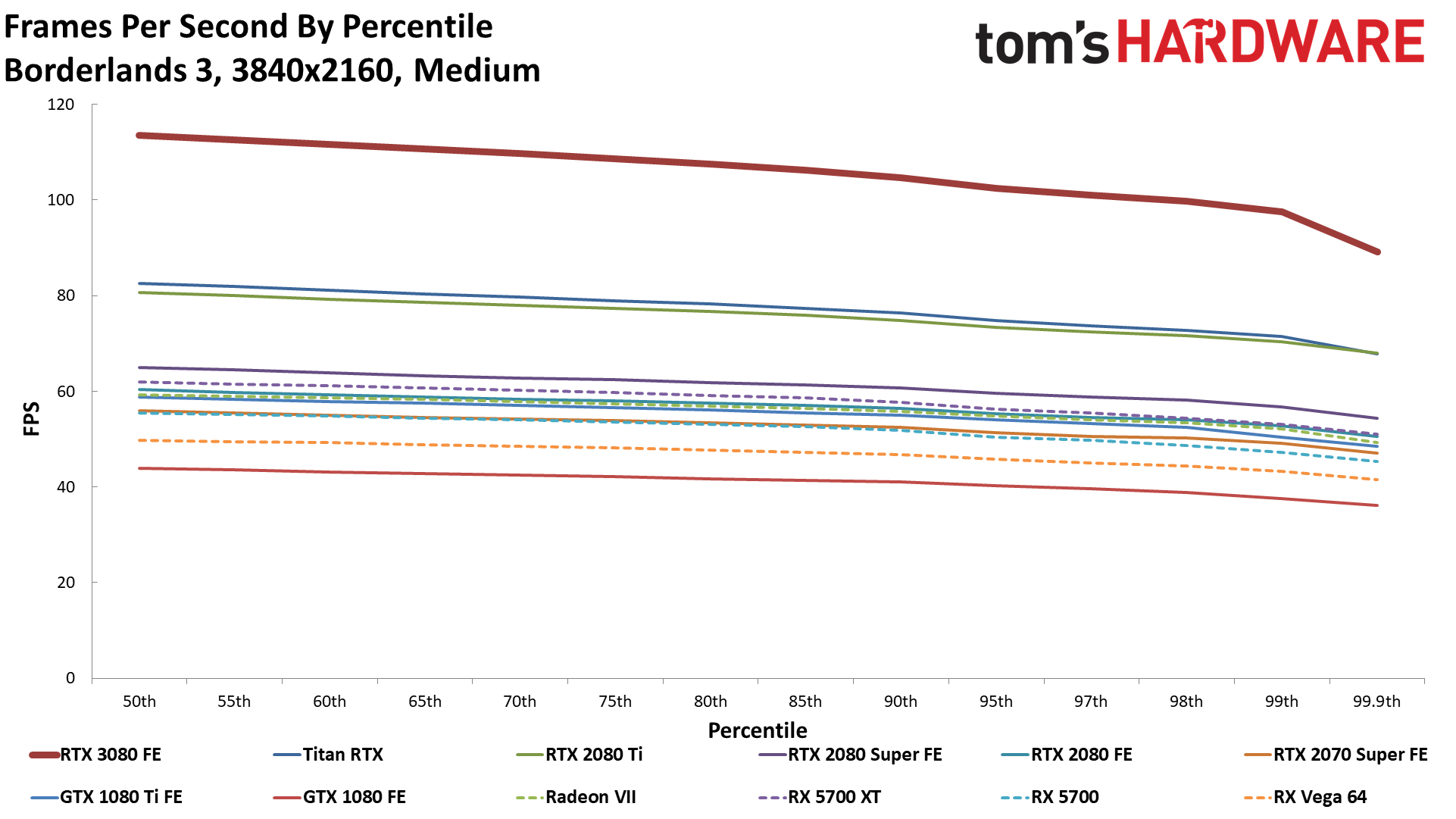
Borderlands 3 is an AMD-promoted game, and we tested using the DirectX 12 (DX12) API. It's a demanding game that pushes GPUs more than normal, and in fact, it gave the RTX 3080 its second-largest margin of victory (give or take) over the other GPUs. RTX 3080 beat the RTX 2080 by 81% this time, and interestingly that grows to 88% at 4K medium. It's also 68% faster than the 2080 Super (75% at medium), 34% faster than the 2080 Ti (39% at medium), and 73% faster than the RX 5700 XT (85% at medium), which is AMD's best showing this time.
Get Tom's Hardware's best news and in-depth reviews, straight to your inbox.
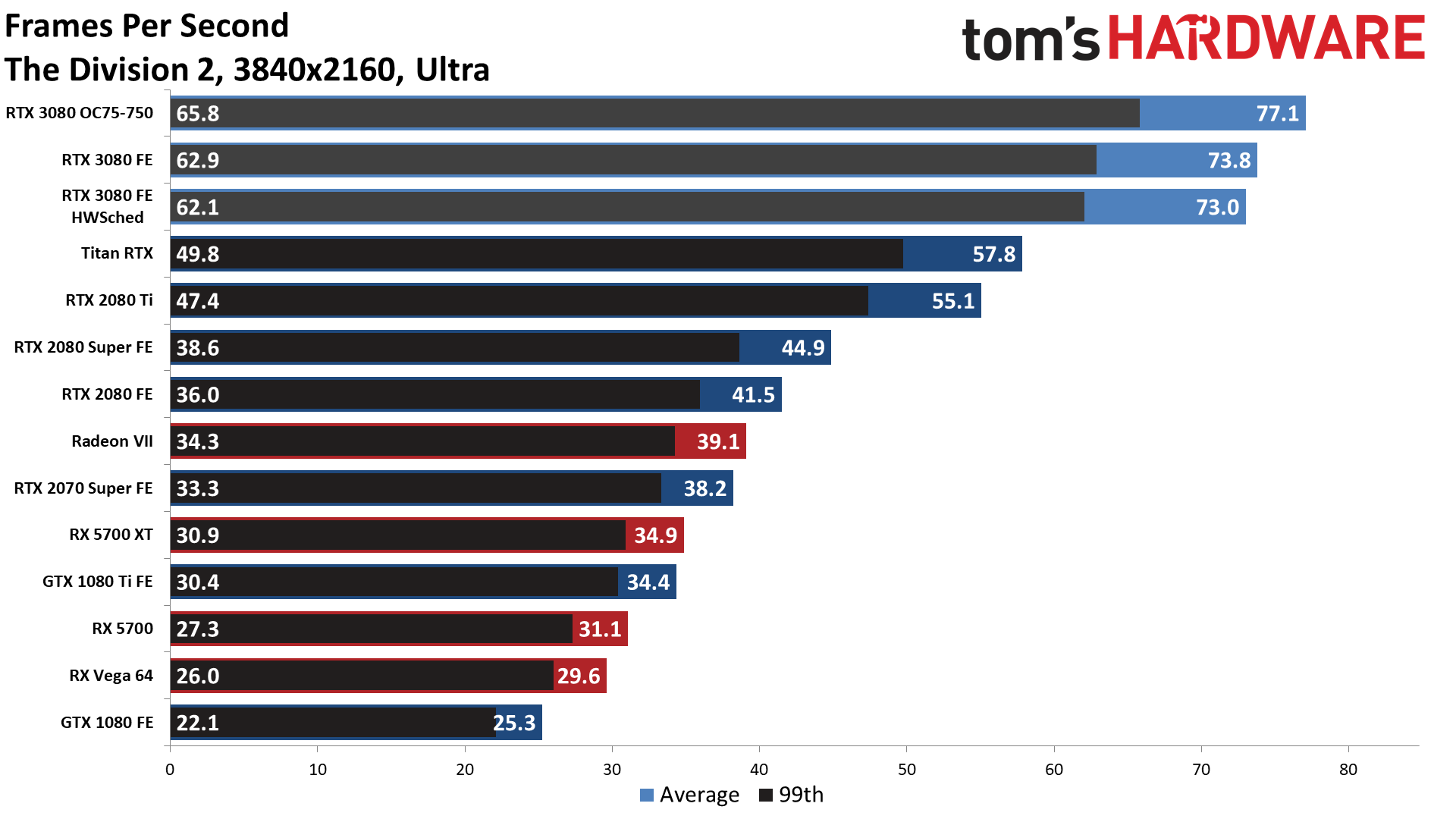
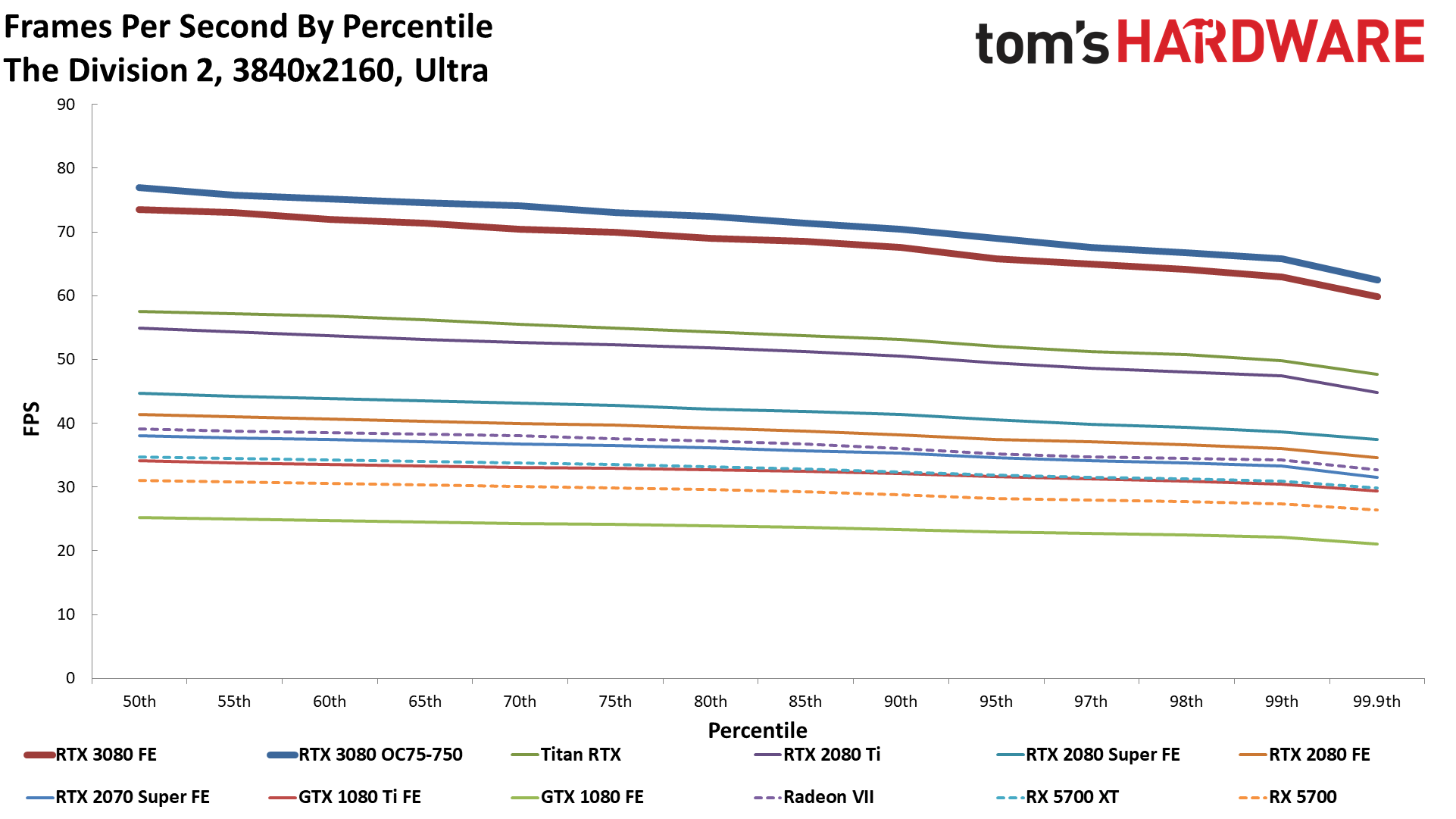
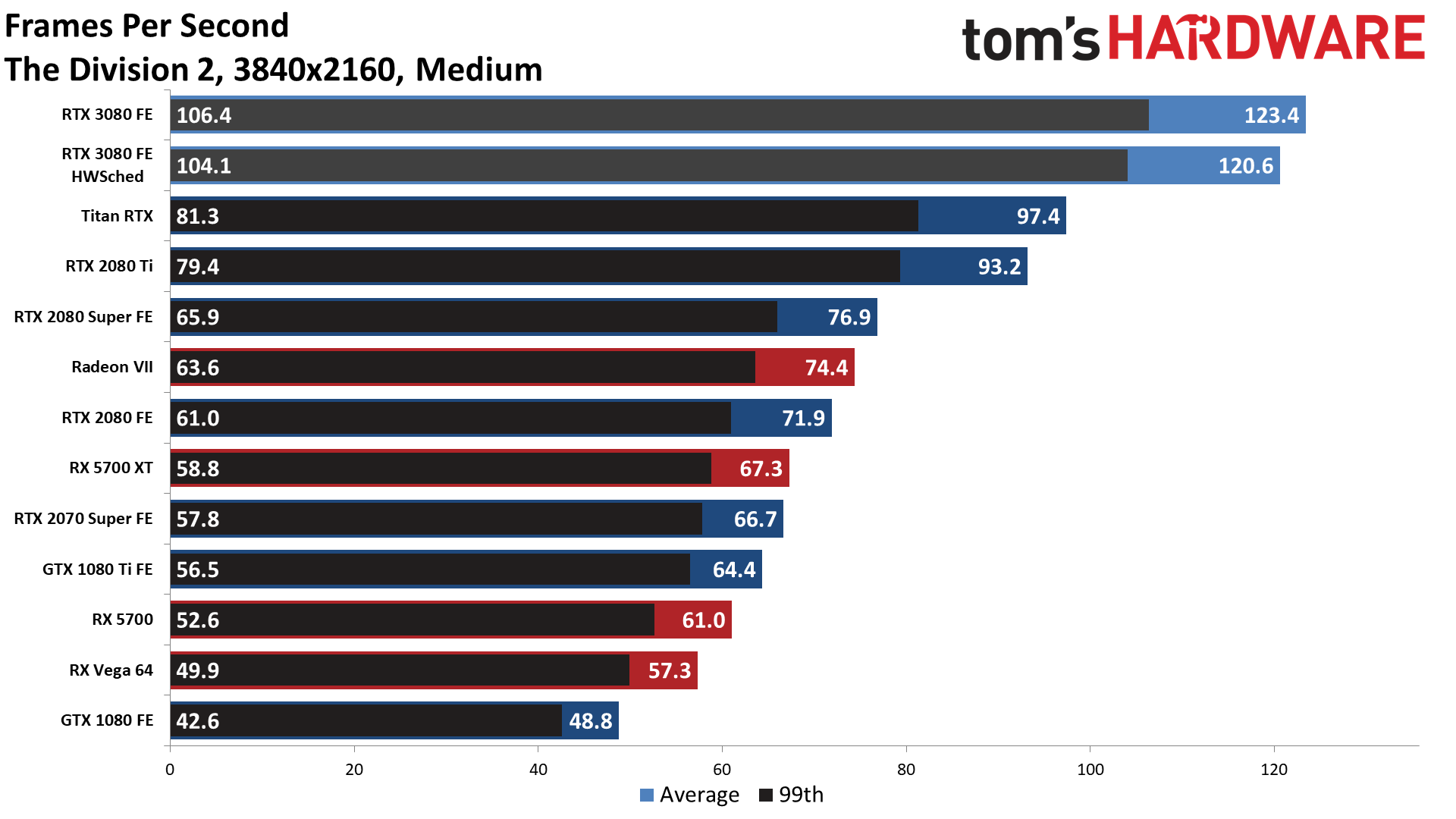
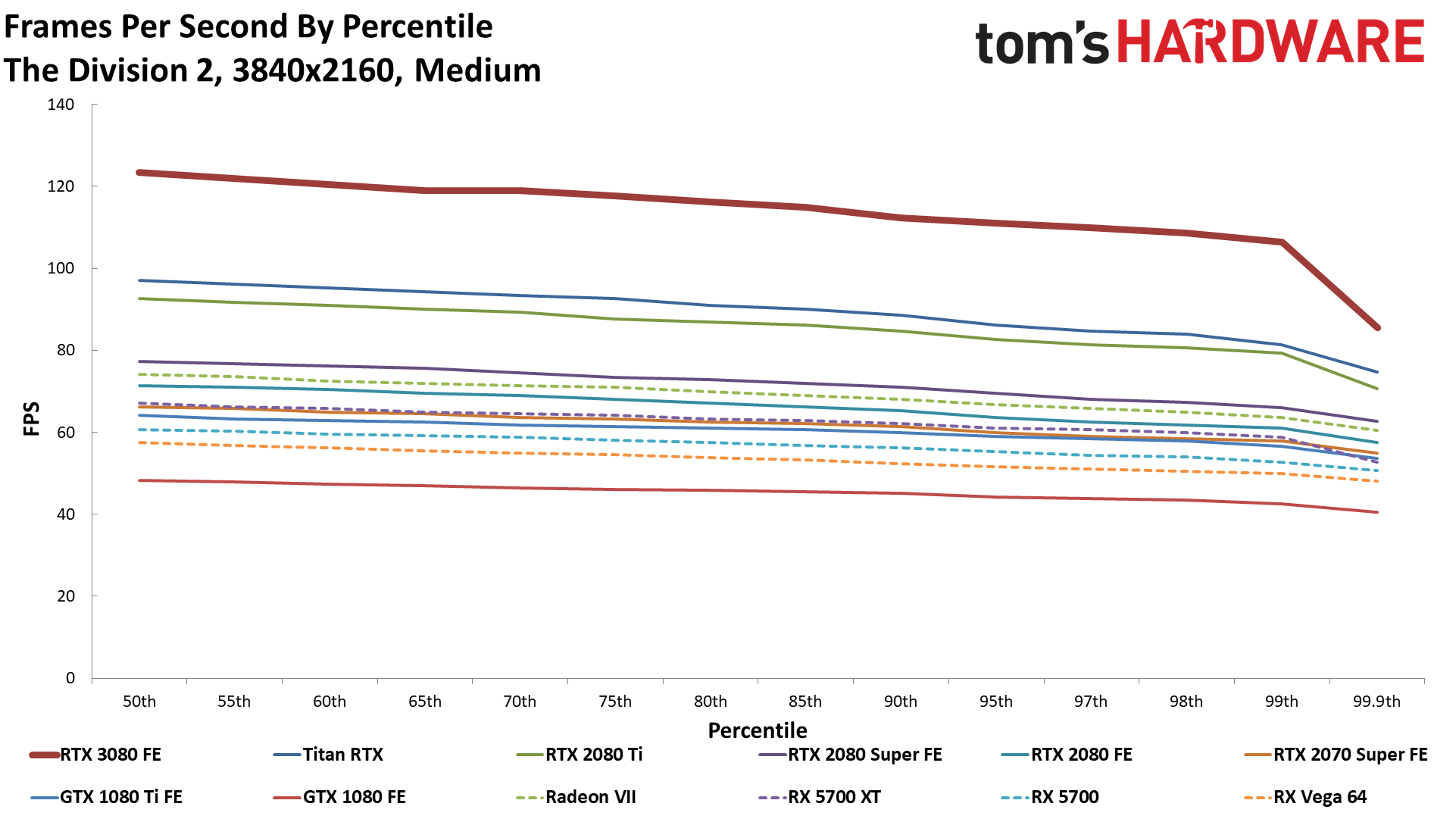
The Division 2 is another AMD-promoted game, though it is perhaps less shader or geometry intensive. It's not clear, but AMD's Radeon VII jumped back ahead of the RX 5700 XT. Again, we used the DX12 API. The 3080 was 35% faster than the 2080 Ti, 64% faster than the 2080 Super, and 78% faster than the 2080 FE. It also led the Radeon VII by 89% and more than doubled the 5700 XT performance (112% faster). 4K medium narrowed the gap across all the tested GPUs by a few percent, and AMD's GPUs benefited more from medium quality than Nvidia's GPUs — the 3080 was 'only' 84% faster than the 5700 XT and 66% faster than the VII.
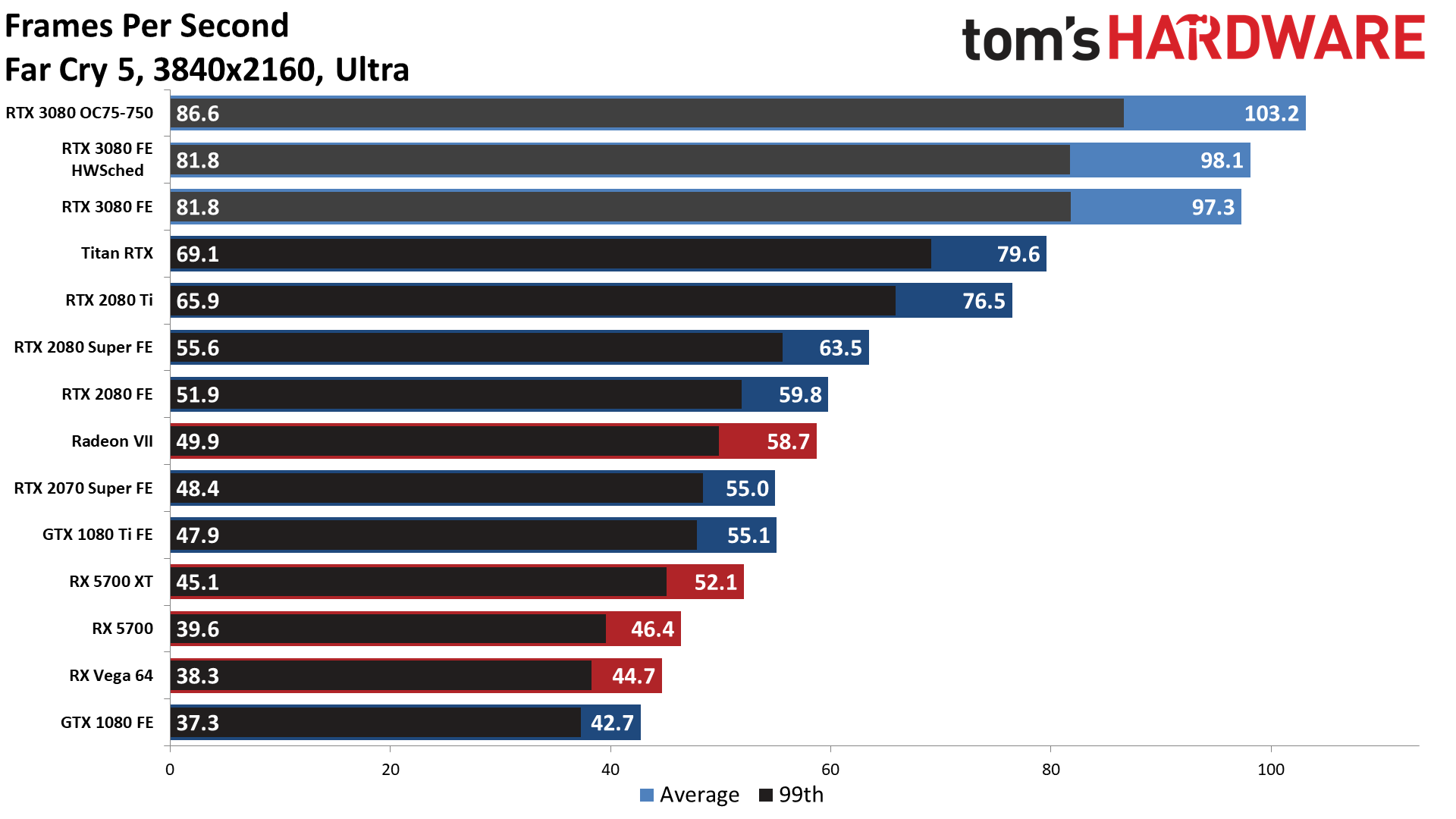
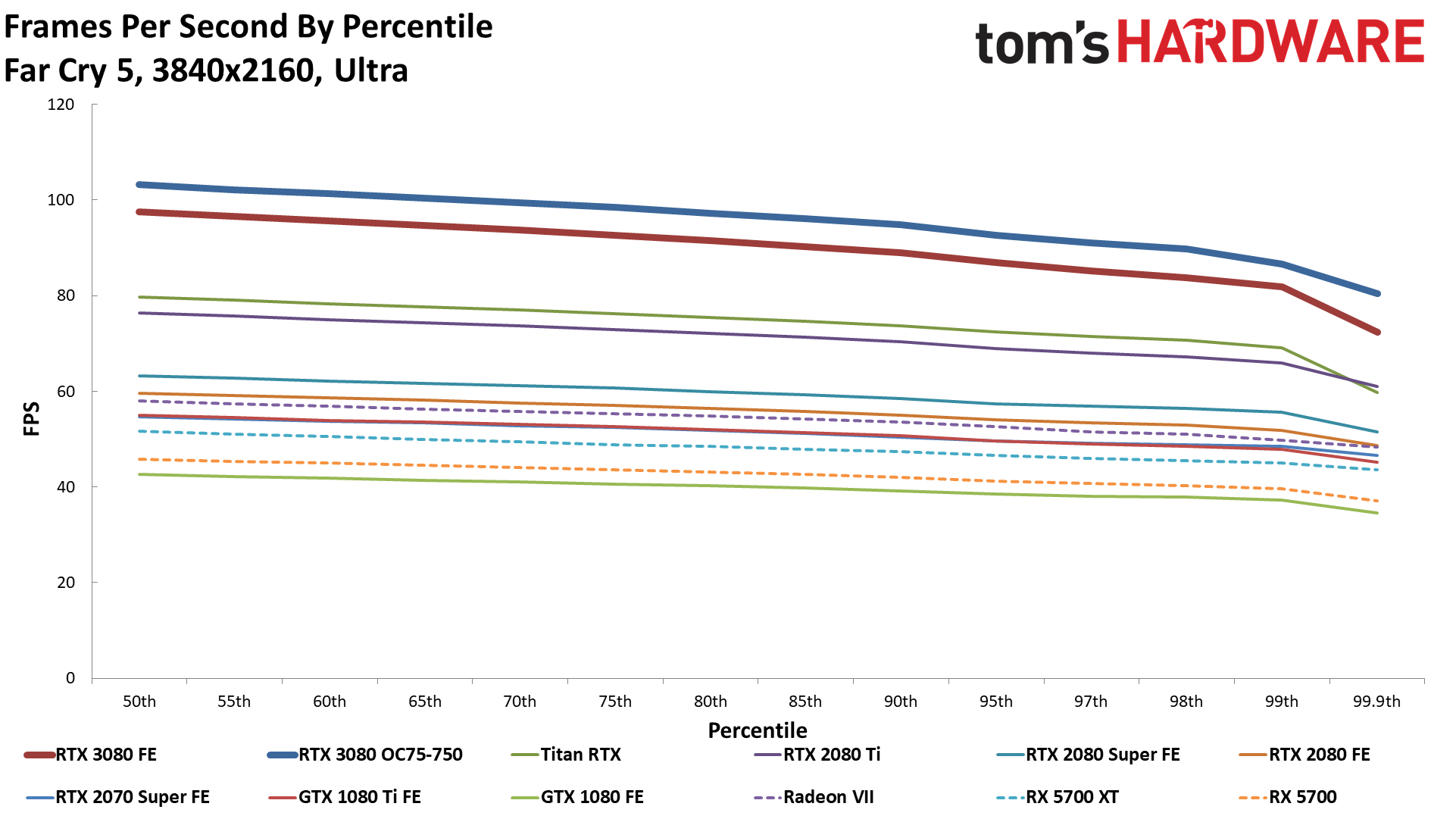
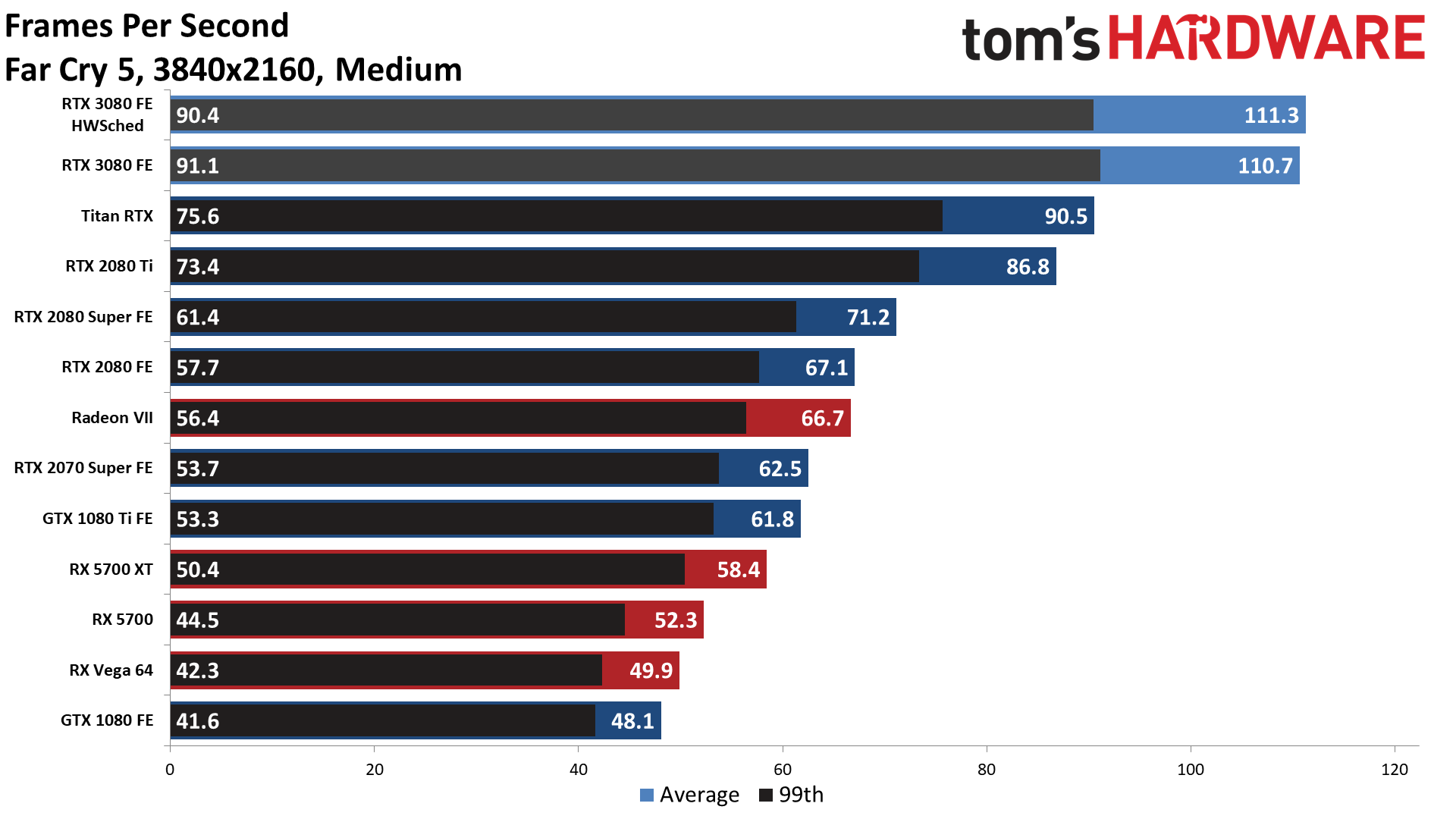
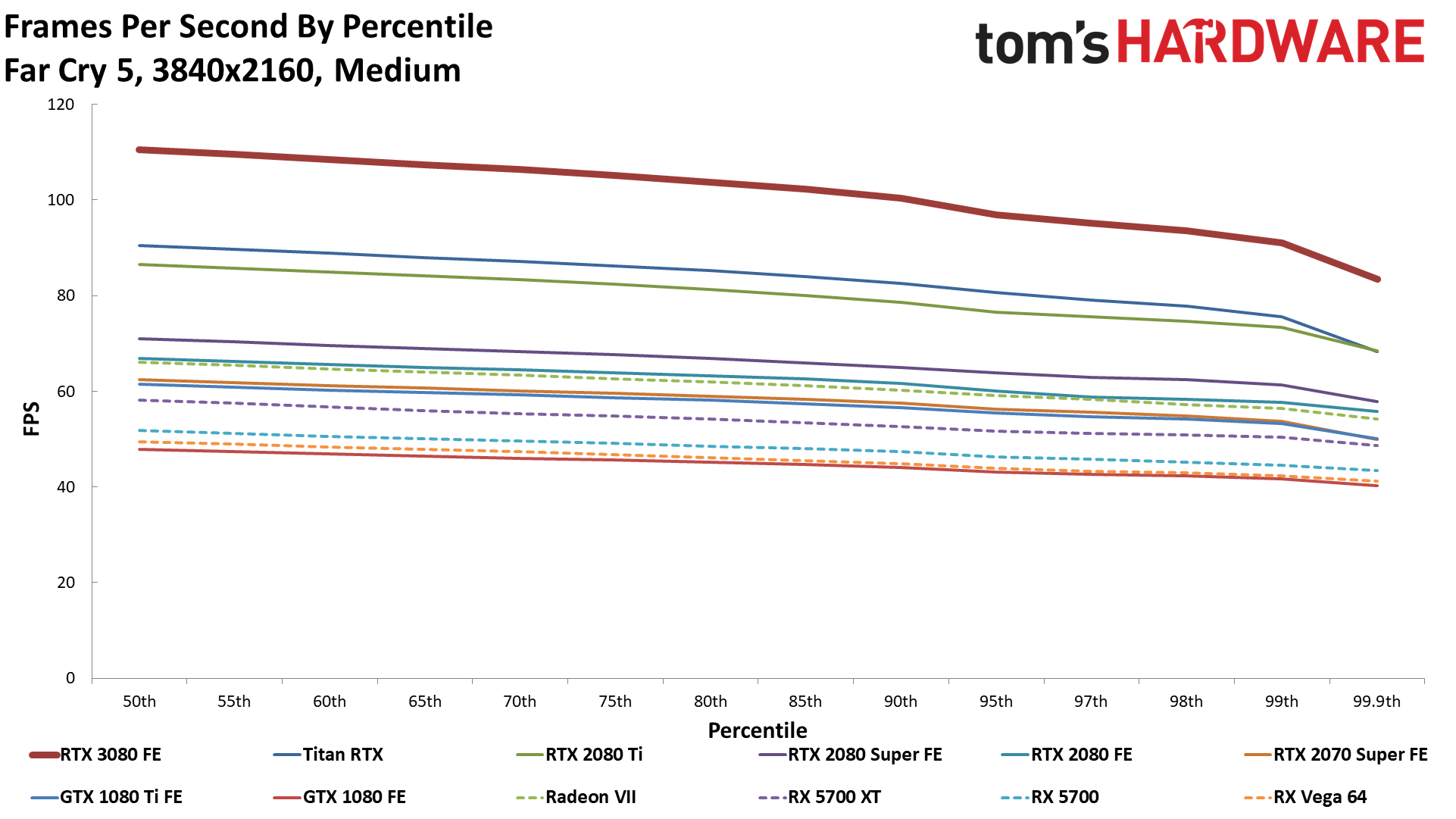
Far Cry 5 is one of the games on our chopping block for GPU benchmarks. It's another AMD promoted title, but it's a bit old and doesn't push modern hardware quite as hard as other games. Plus, Far Cry 6 is coming soon-ish (Feb 2021), which will likely replace it. The game definitely hits some CPU bottlenecks, so it's one of the lesser victories for the RTX 3080. The lead over the 2080 FE was only 63% at 4K ultra, or 65% at 4K medium, and less than 30% ahead of the 2080 Ti.
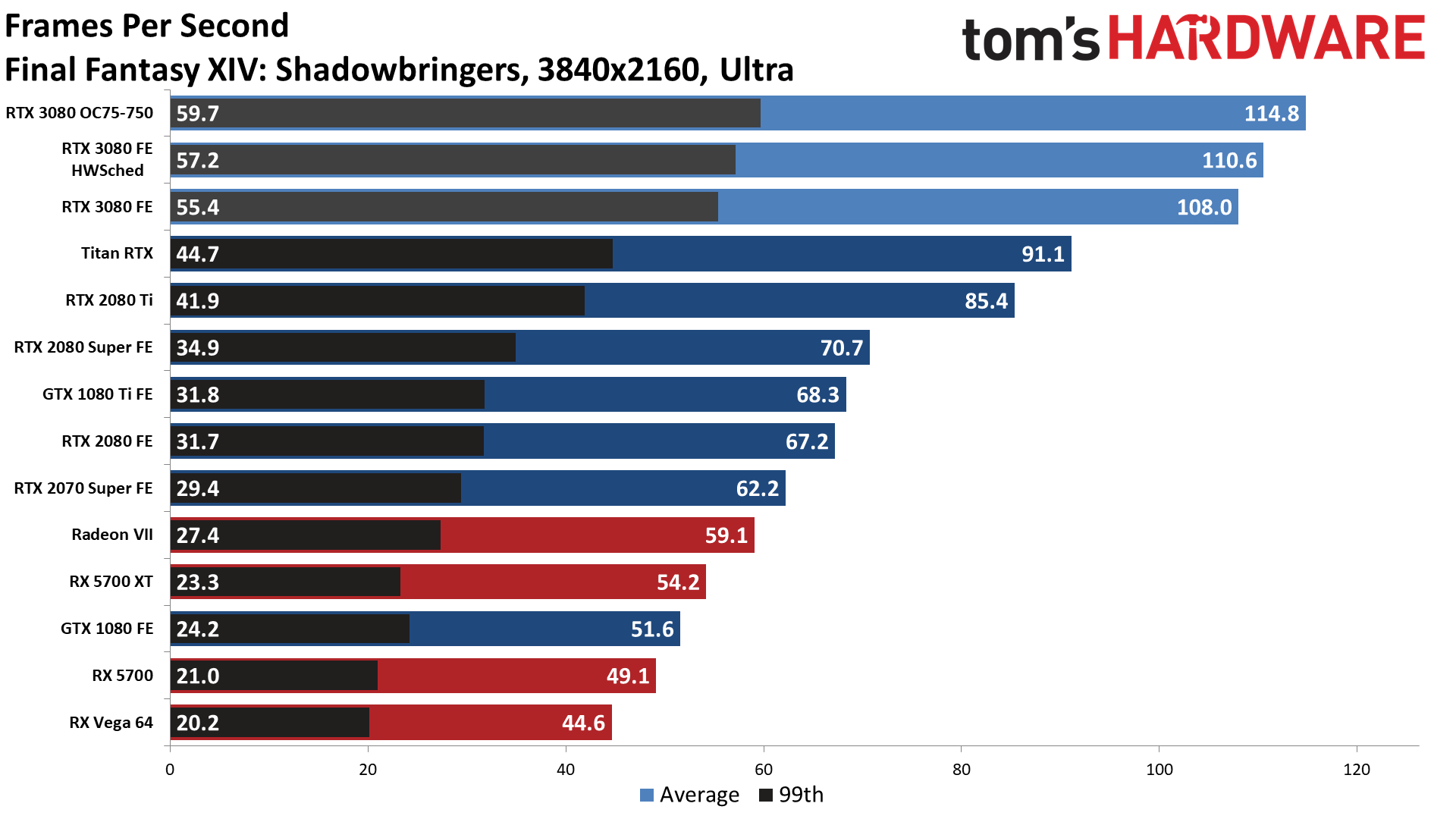
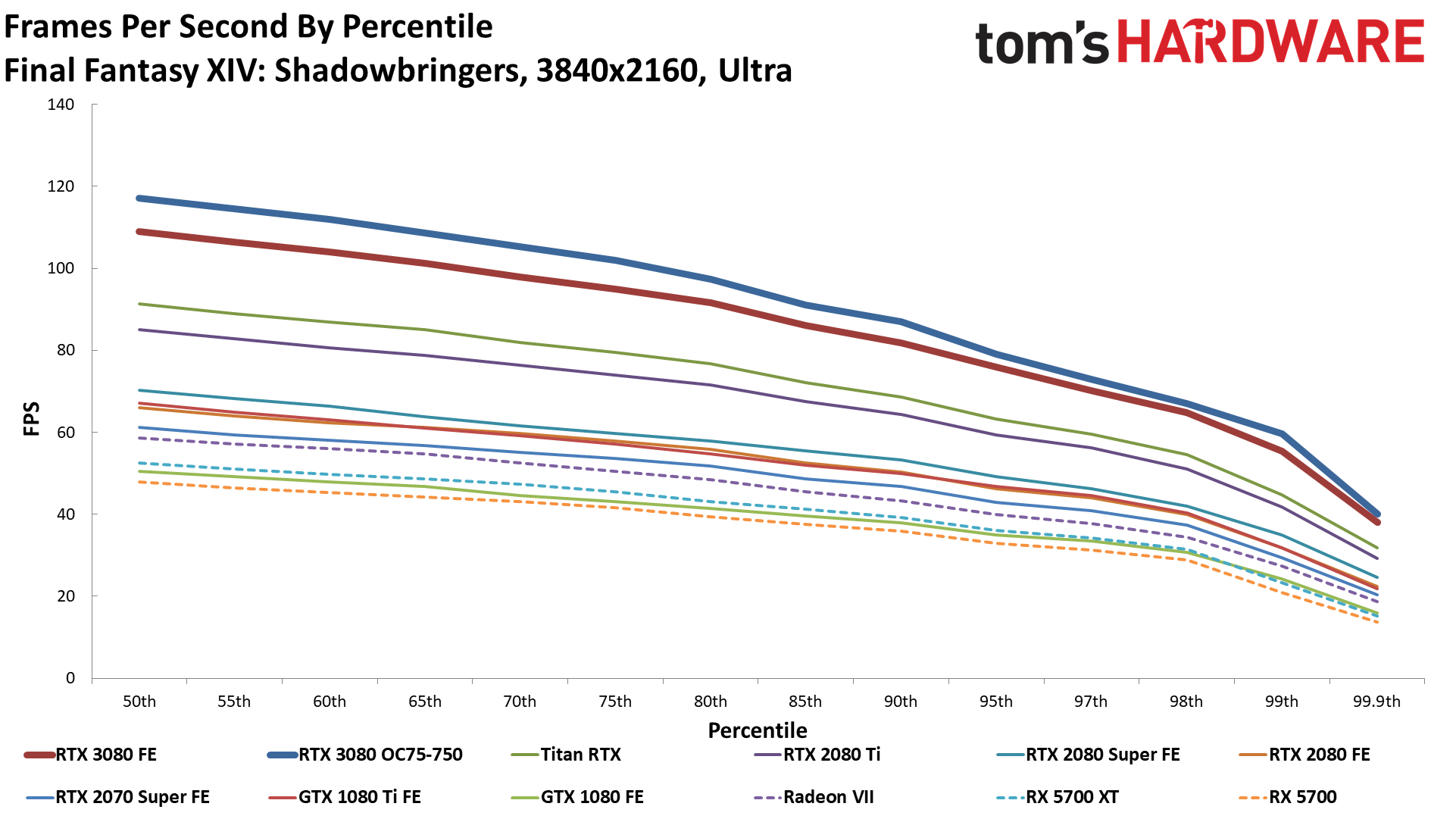
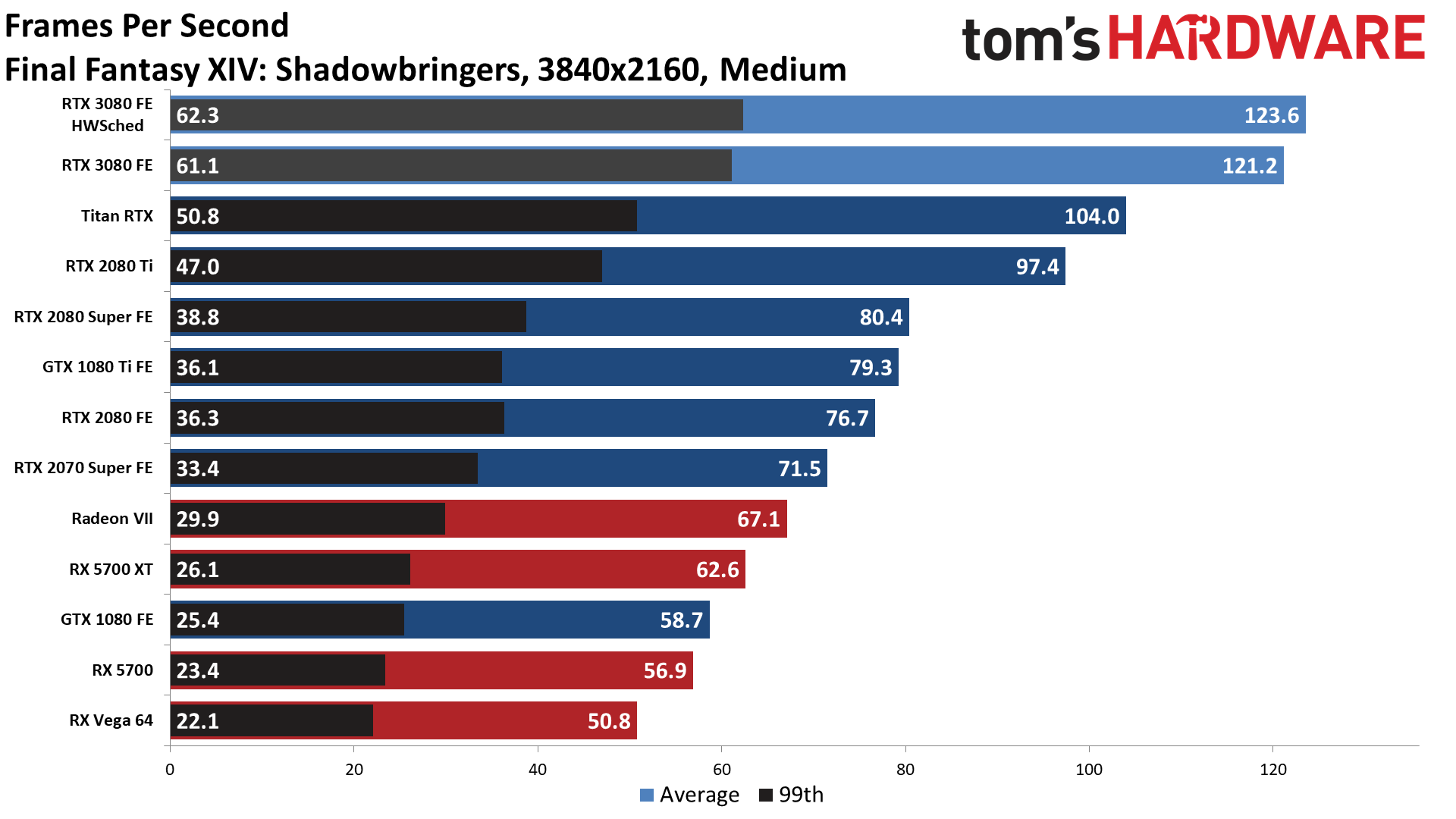
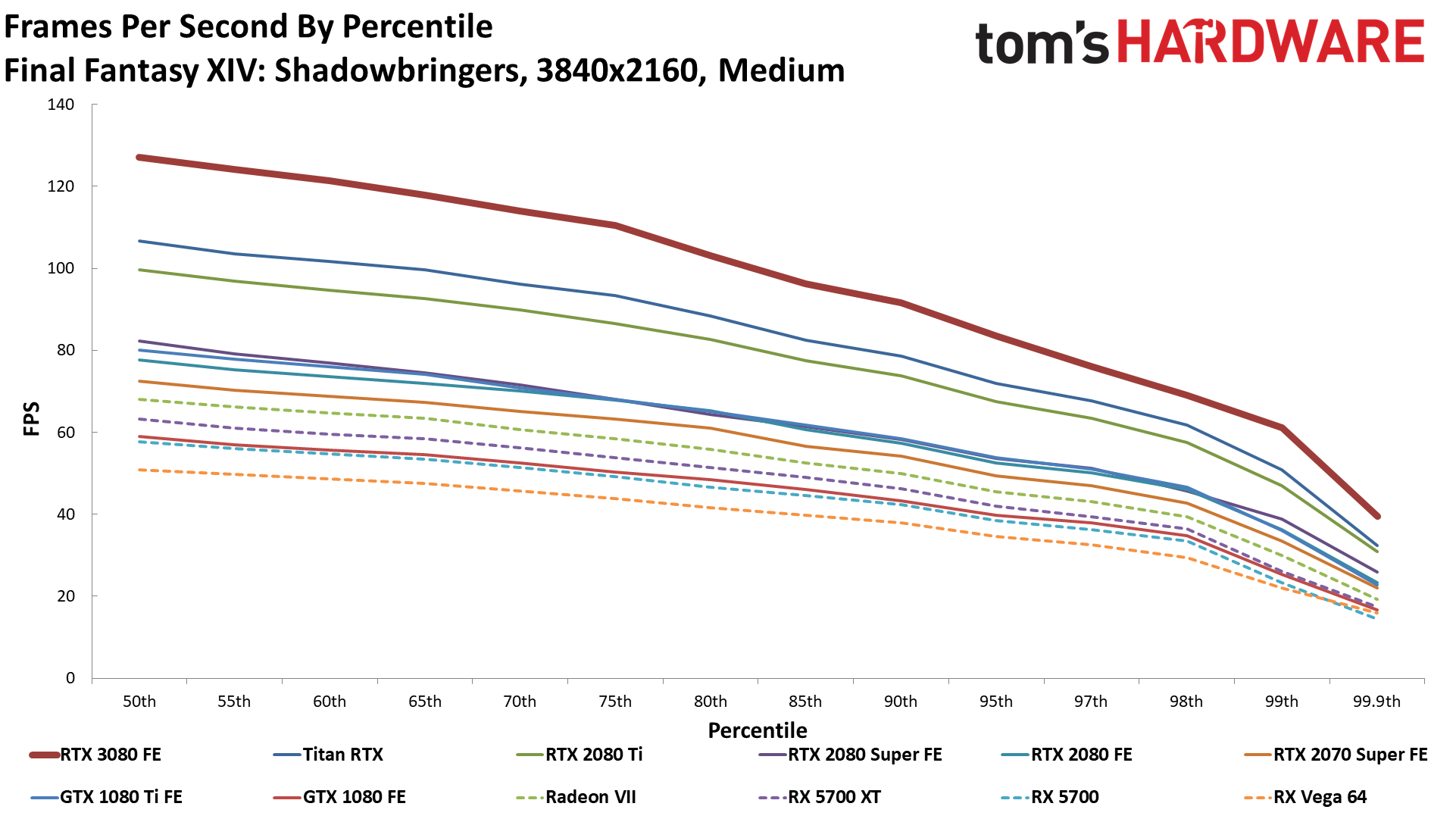
Final Fantasy XIV is also ready for retirement, and it showed similar results to Far Cry 5. RTX 3080 beat the 2080 FE by 61% (58% at medium). Final Fantasy XIV does make use of some of Nvidia's GameWorks libraries, which also leads to larger victories over AMD this time. The 3080 is over 80% faster than the Radeon VII and 90-100% faster than the RX 5700 XT.
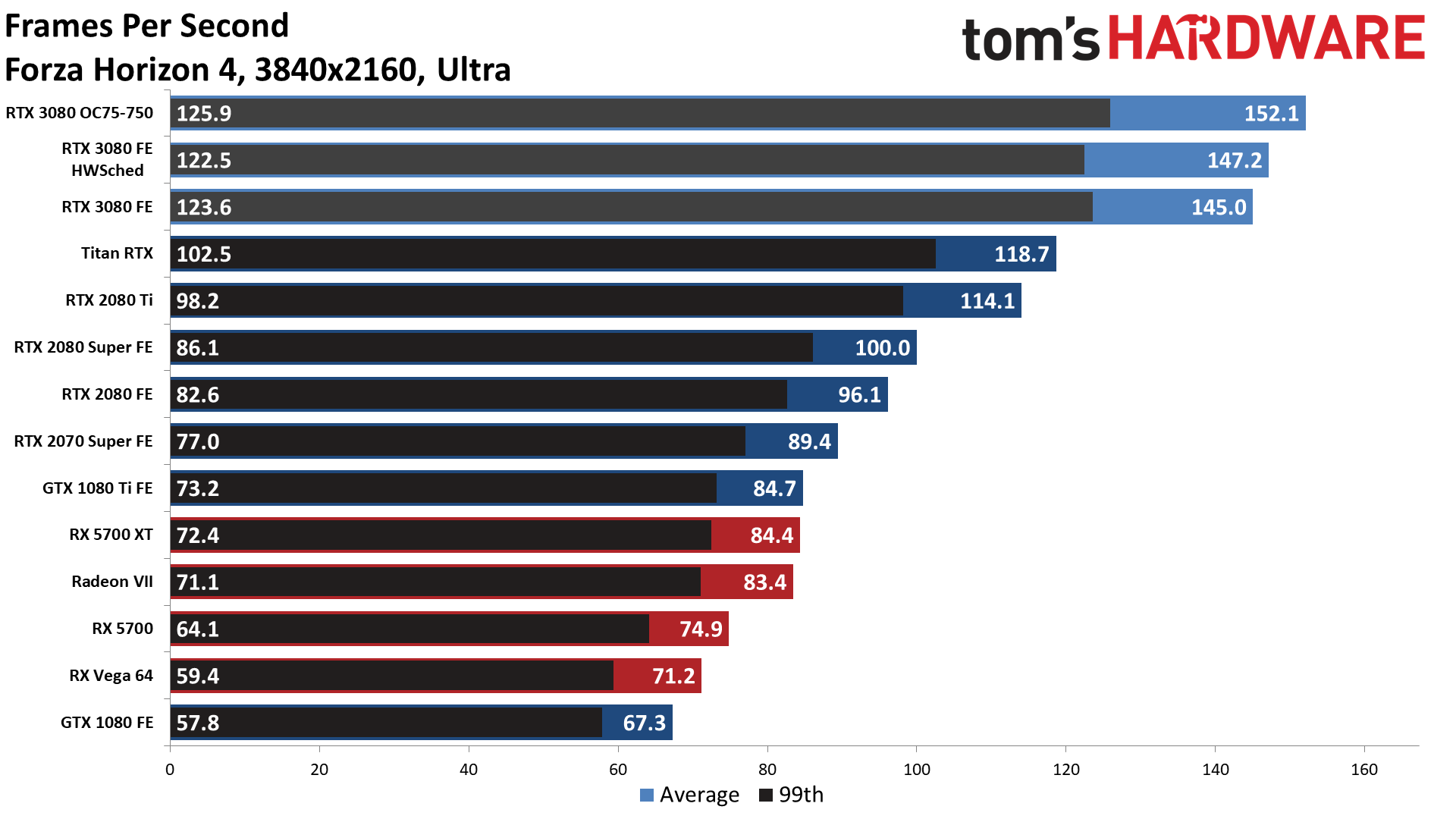
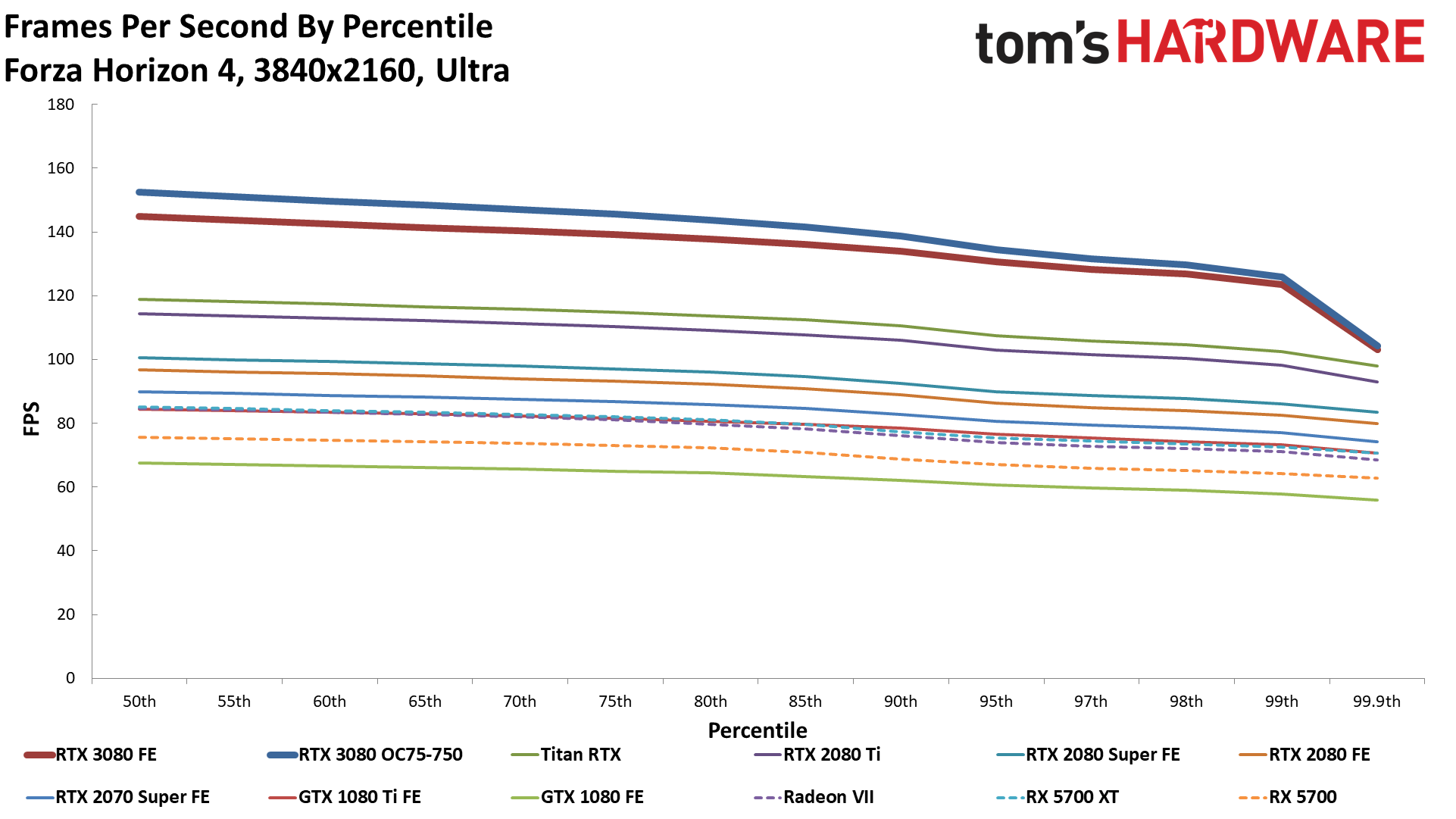
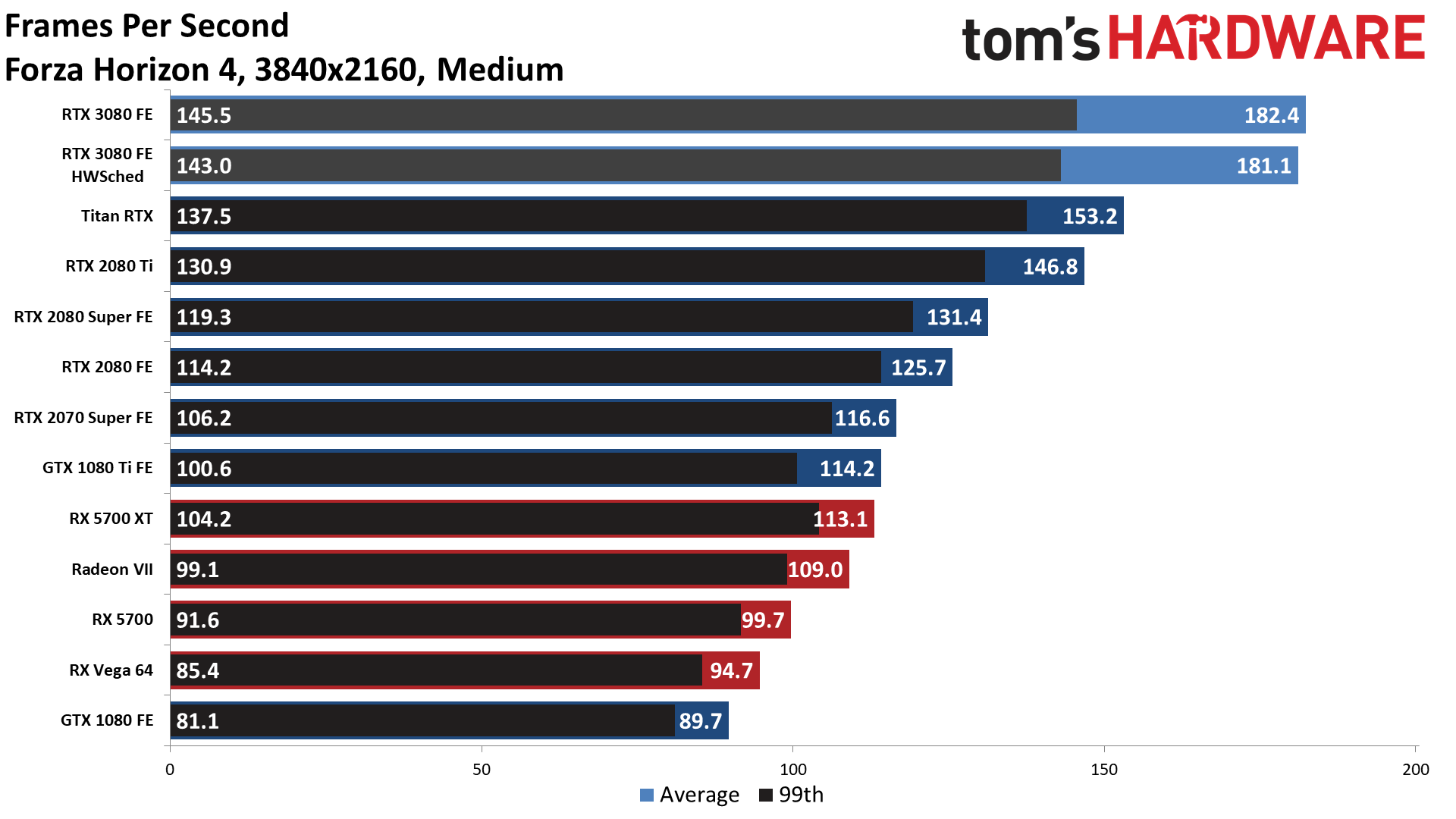
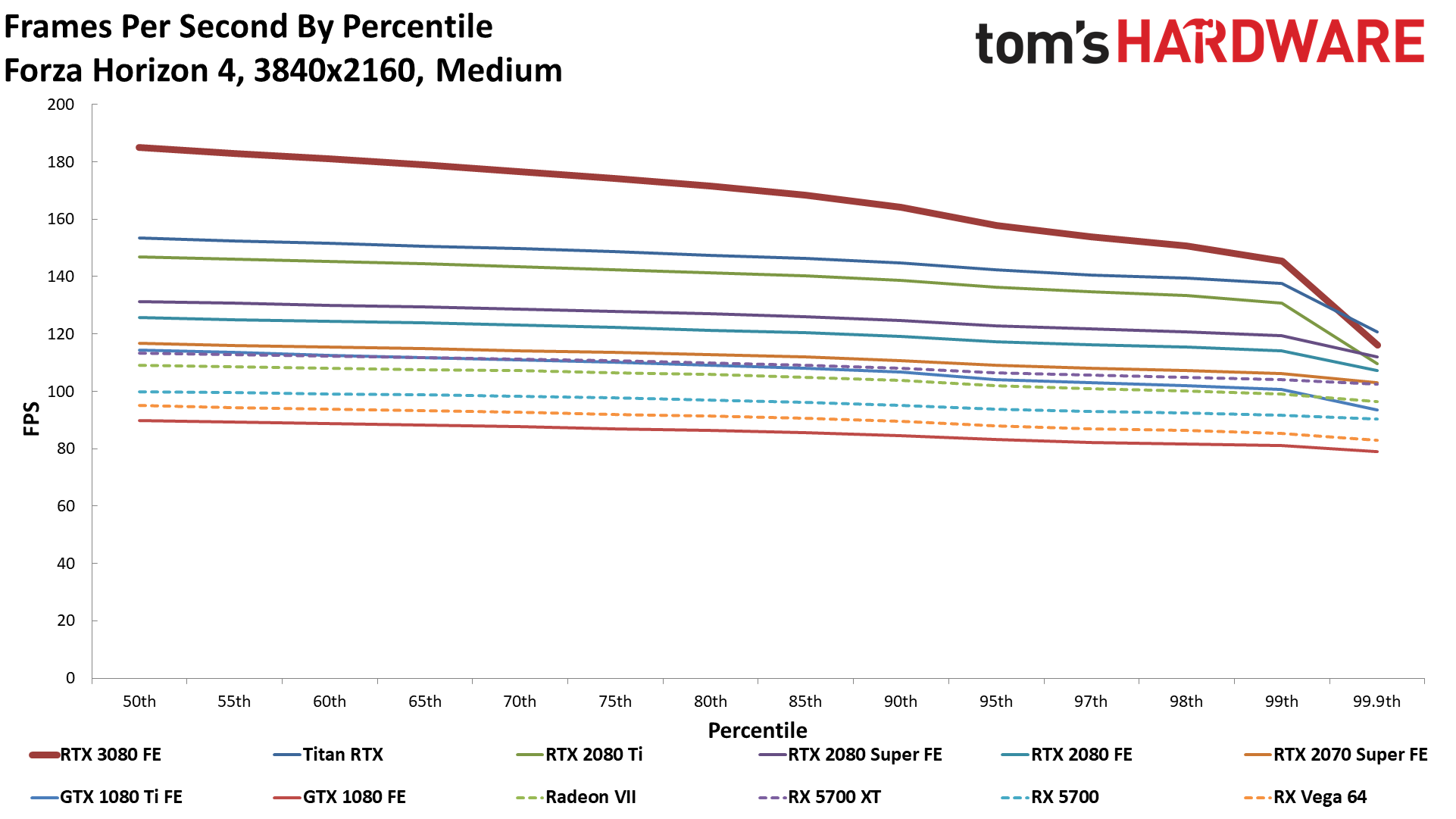
I thought about replacing Forza Horizon 4 with Project CARS 3, but I'm holding off for now. This is our car racing representative, and it's one of the lesser wins for the RTX 3080. The newcomer still bests the previous generation 2080 FE by 50%, and it's 116% faster than the GTX 1080, but all of the cards managed more than 60 fps at 4K ultra. Dropping the settings to 4K medium, Nvidia's fastest GPUs start to encounter more CPU limitations, narrowing the gap between the various cards.
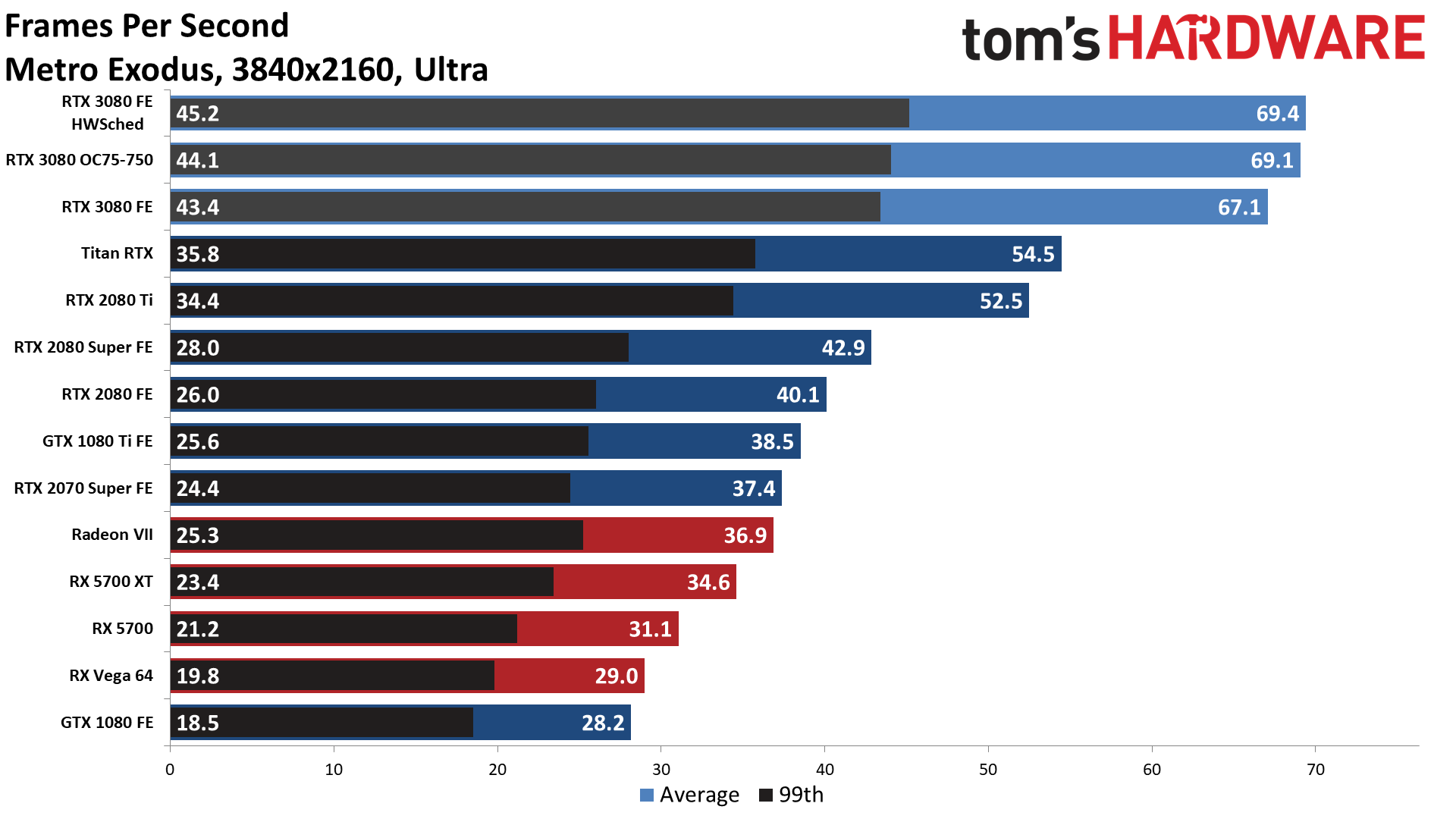
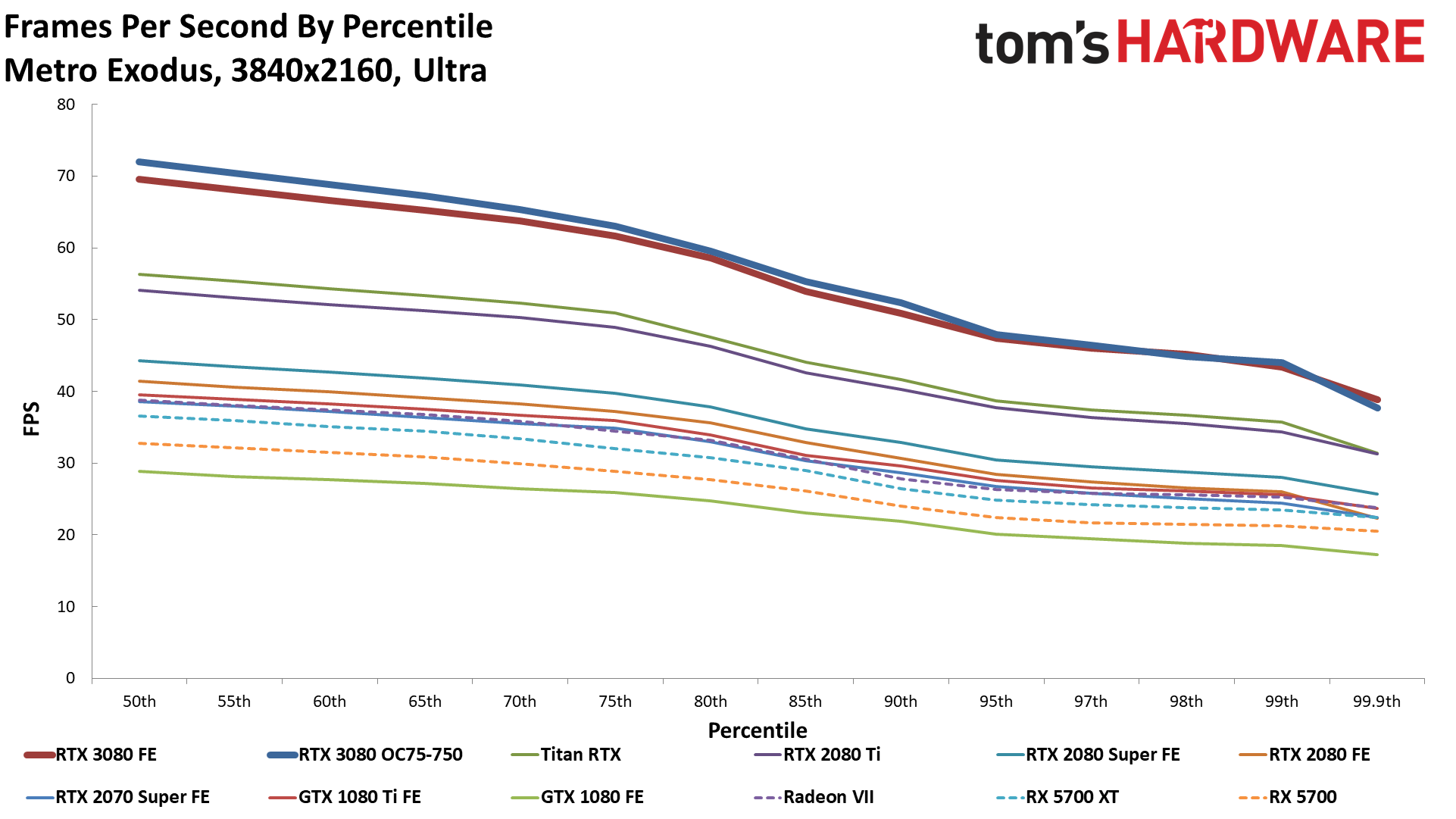
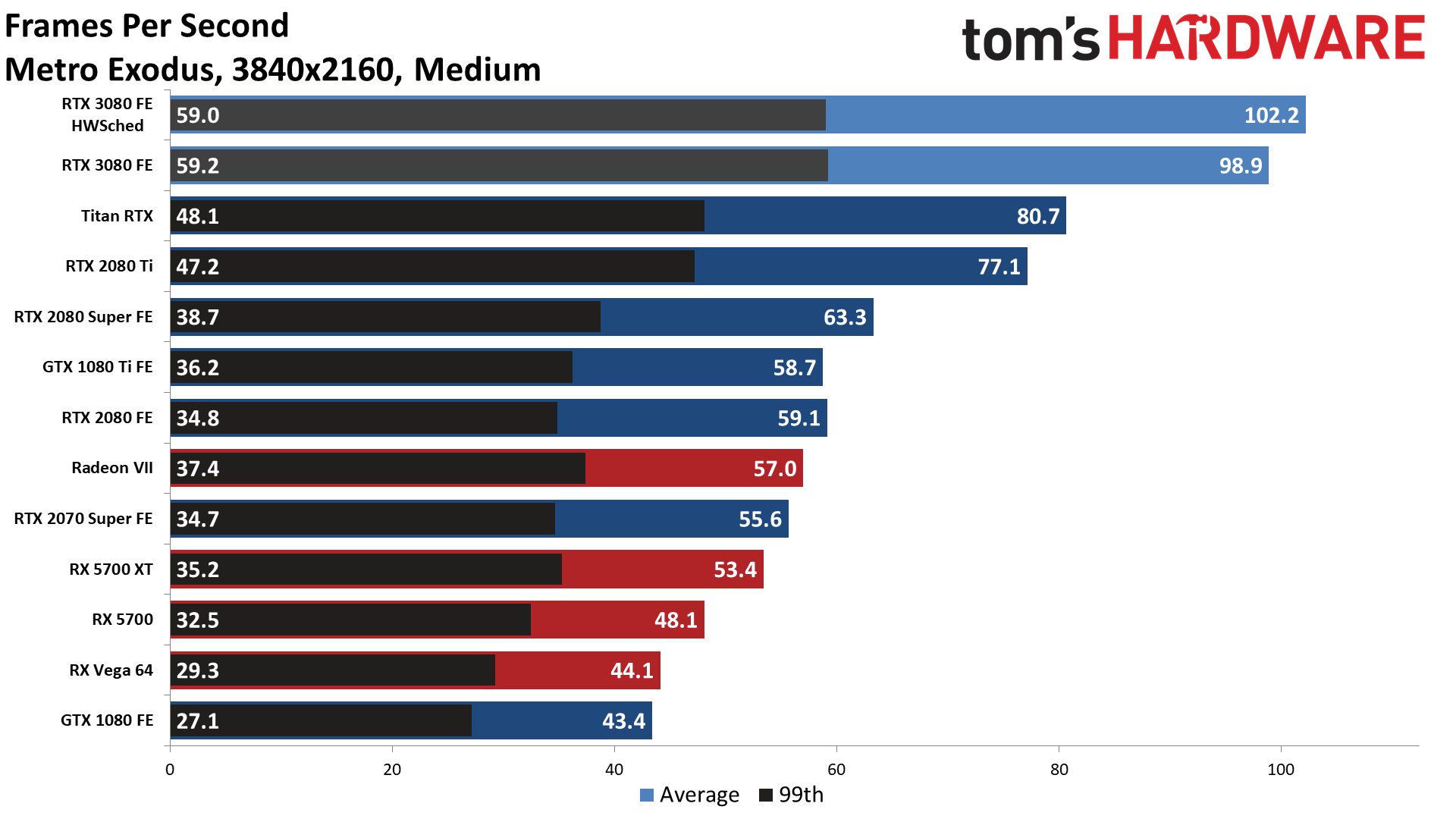
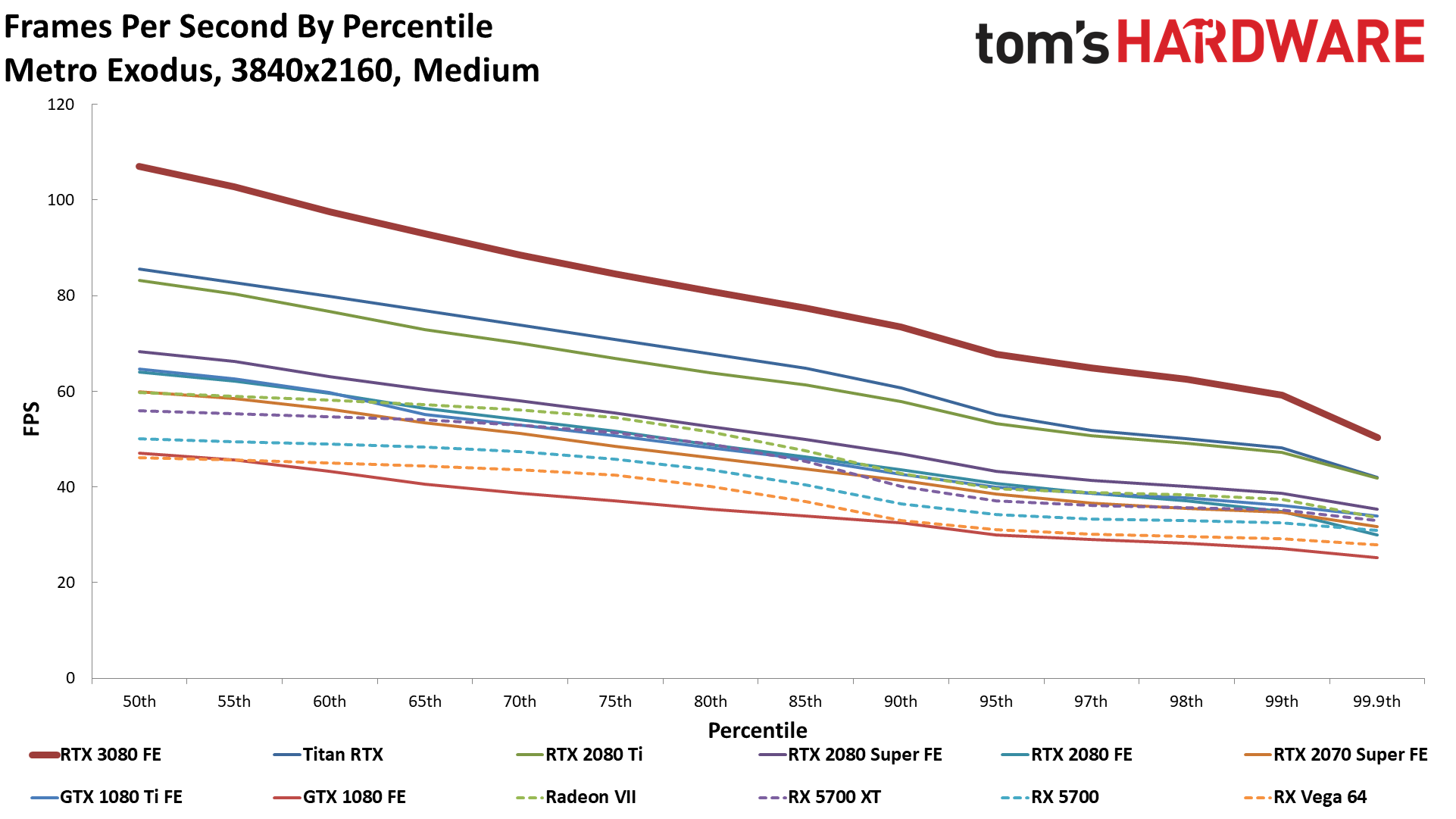
Metro Exodus is another extremely demanding game — and that's without enabling ray-tracing effects. It's an Nvidia-promoted game, though without RT global illumination, it's reasonably agnostic about your GPU choice. The RTX 3080 FE is the first GPU ever to break 60 fps at 4K ultra, running at stock clocks. And let's be clear that minimum fps still fell below that mark regularly. Still, the 3080 basically matches its overall average, beating the 2080 FE by 67% and the 5700 XT by 94%.
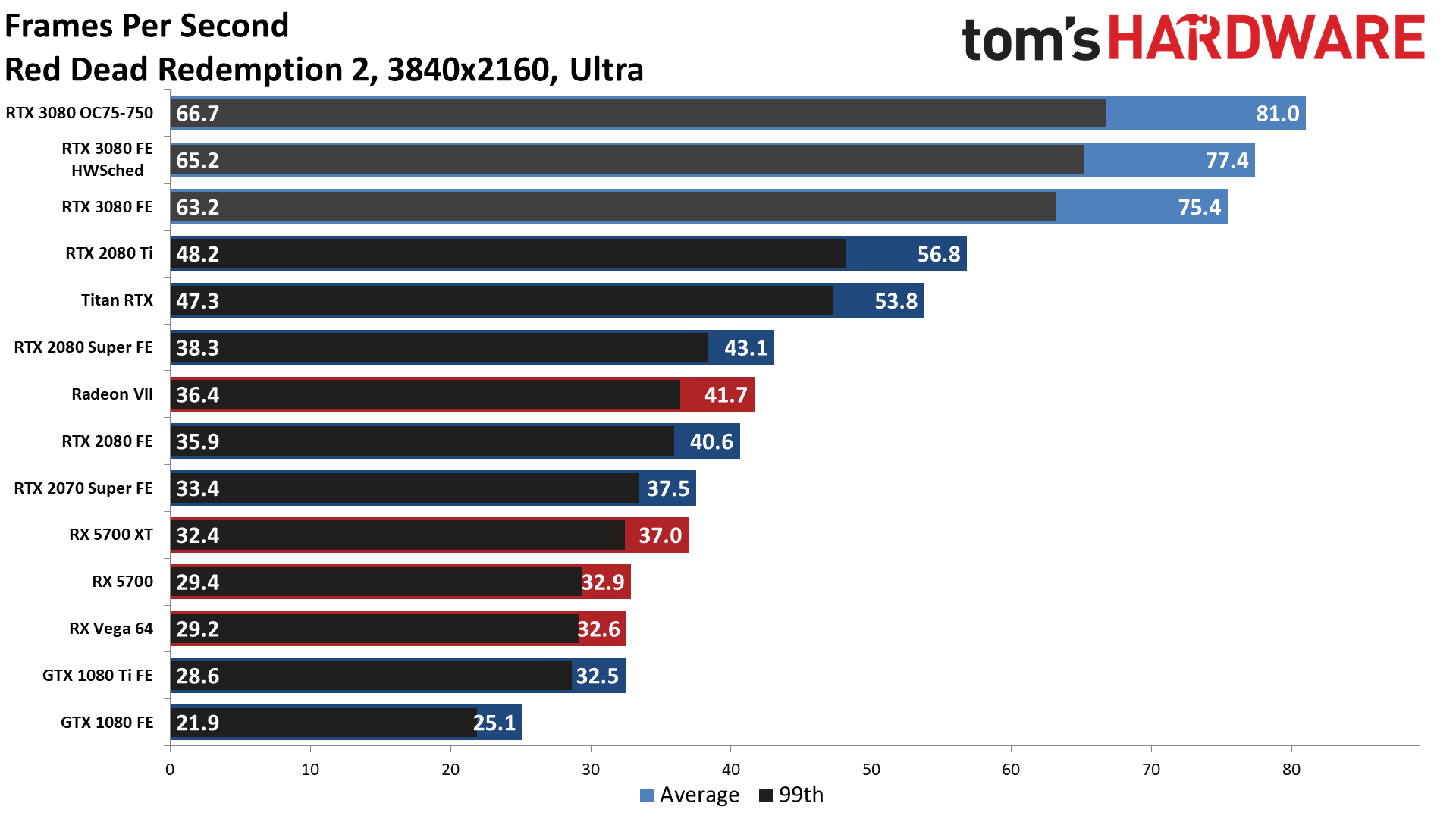
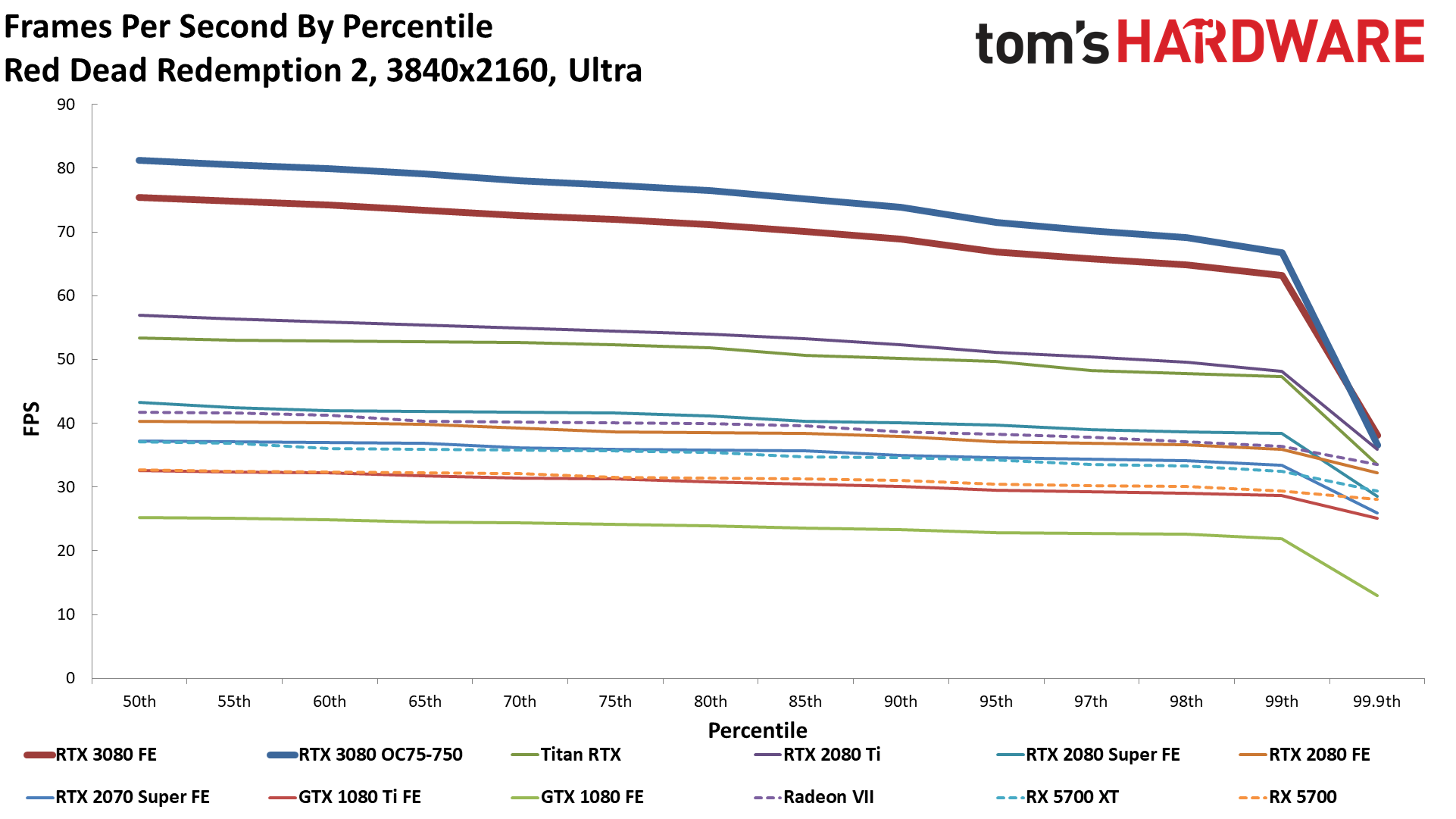
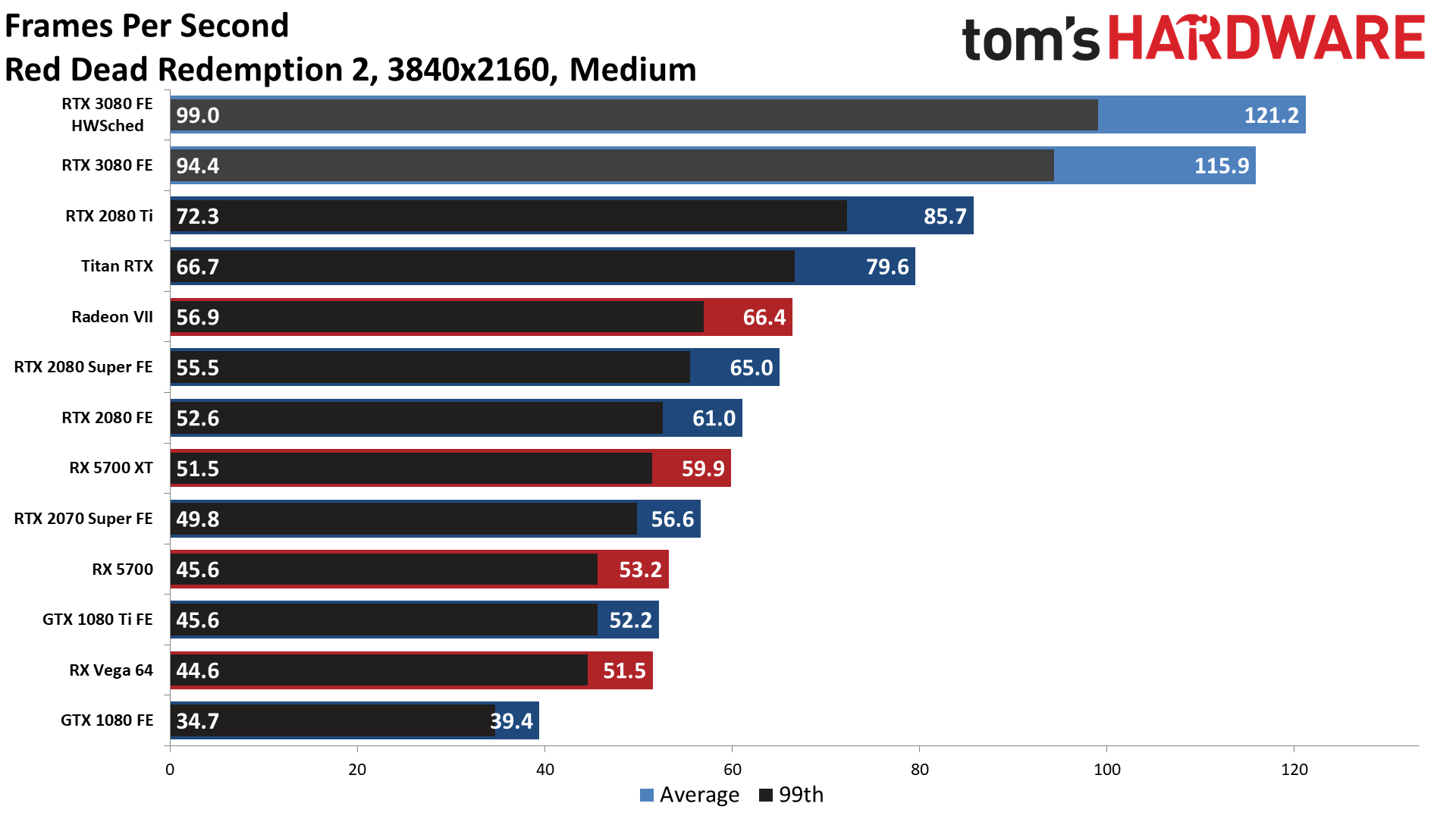
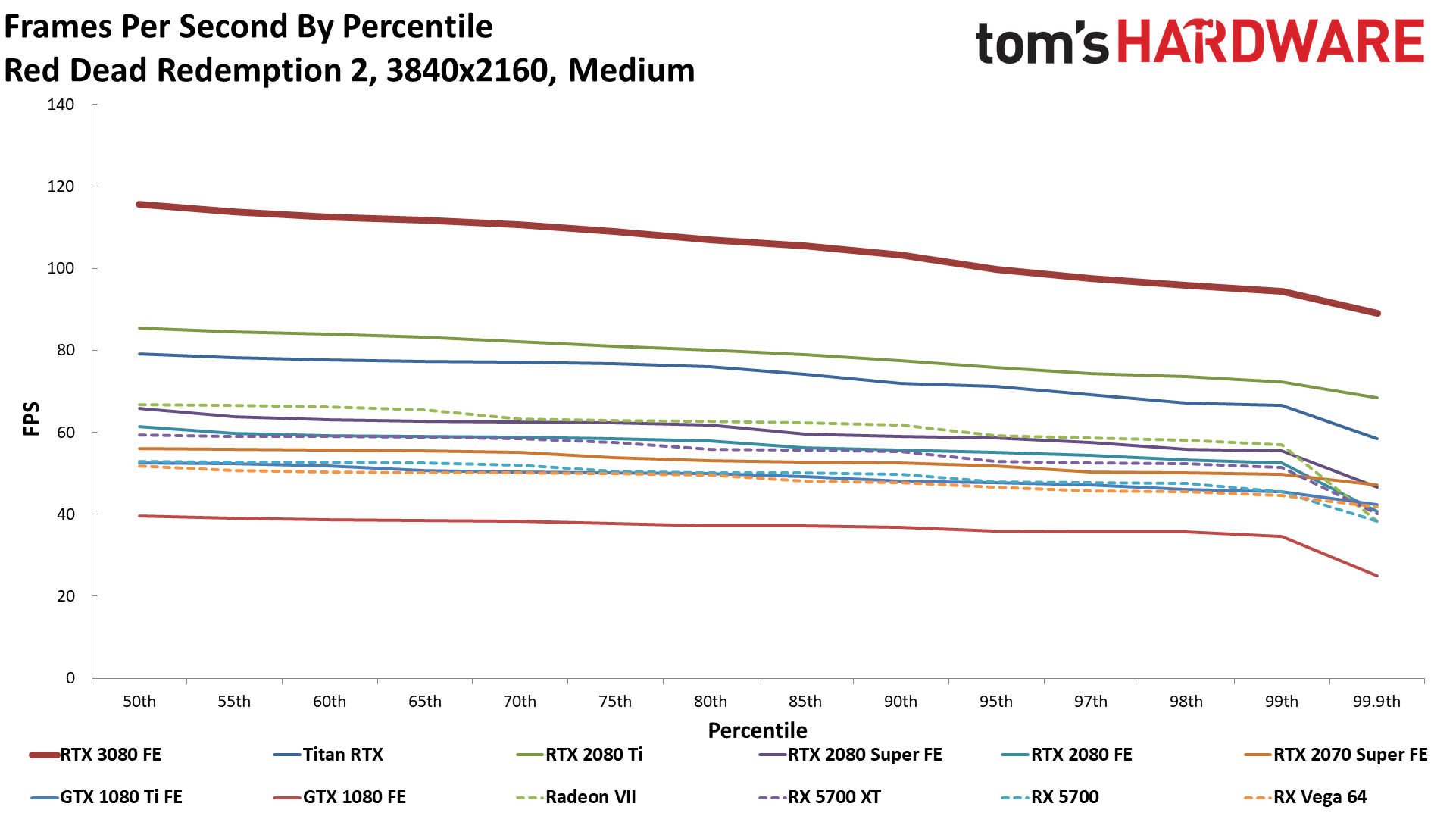
Borderlands 3 is the second-most demanding game in our suite, with top honors going to Red Dead Redemption 2 — which we're not even running at maxed-out settings. We set all of the settings to minimum, then change all of the top (non-advanced) settings to medium or maximum (high/ultra). It's how we started doing testing months ago, and we've stayed with it since the game doesn't have built-in presets. Not surprisingly, as the most demanding game in our test suite, the RTX 3080 also saw some of its biggest leads. It was 86% faster than the 2080 FE, 47% faster than the 2080 Ti, and over twice as fast as the RX 5700 XT.
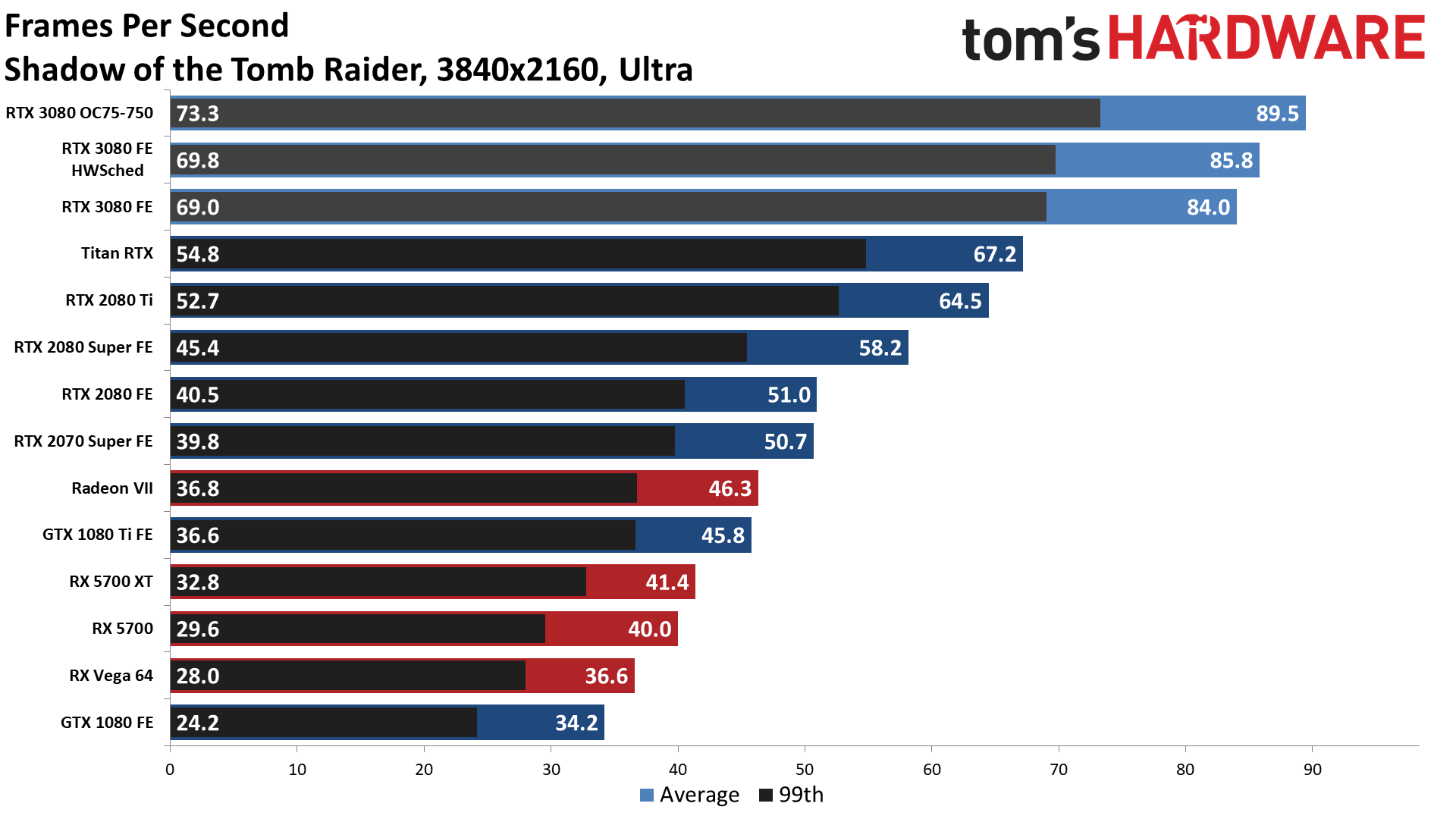
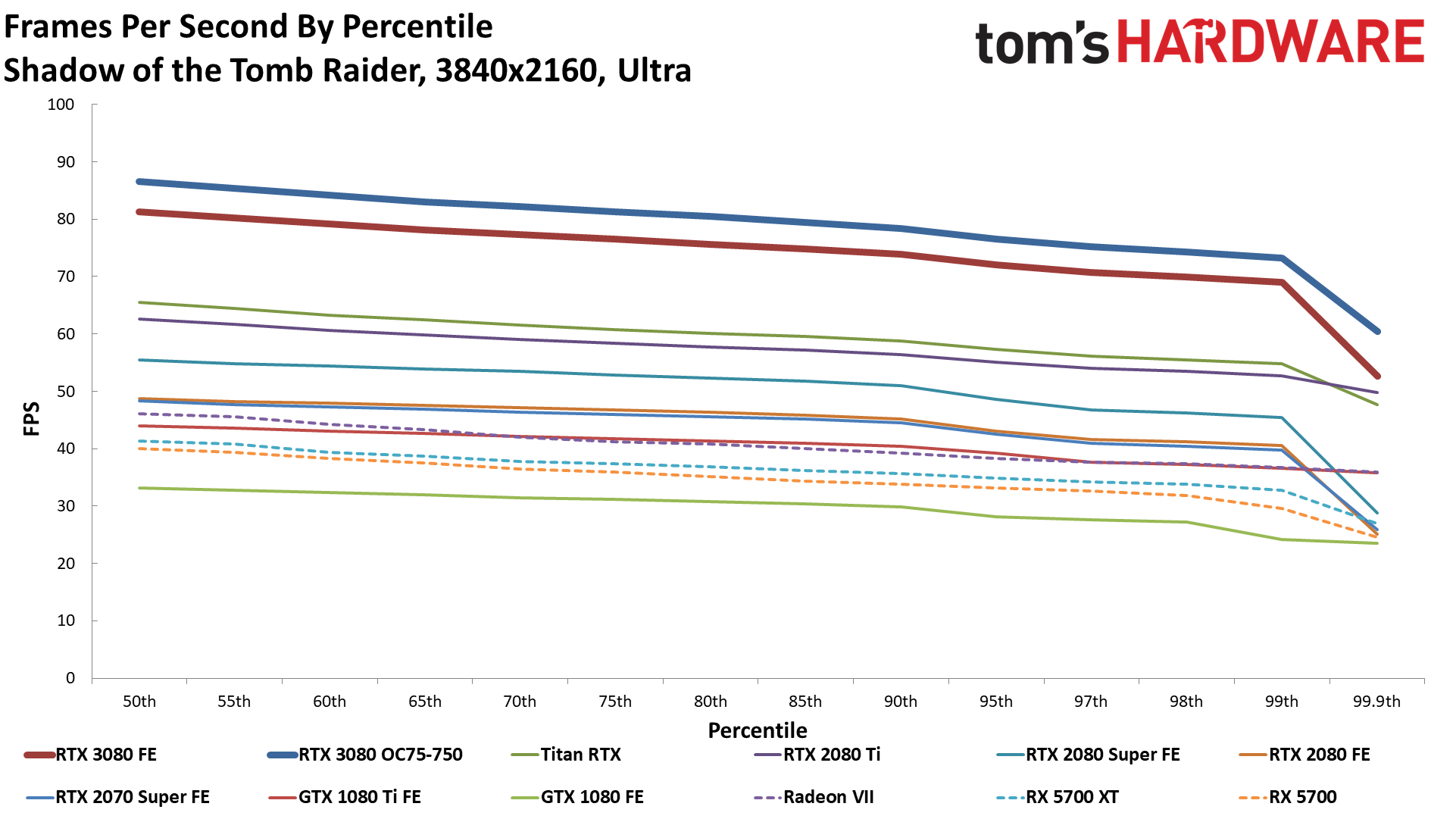
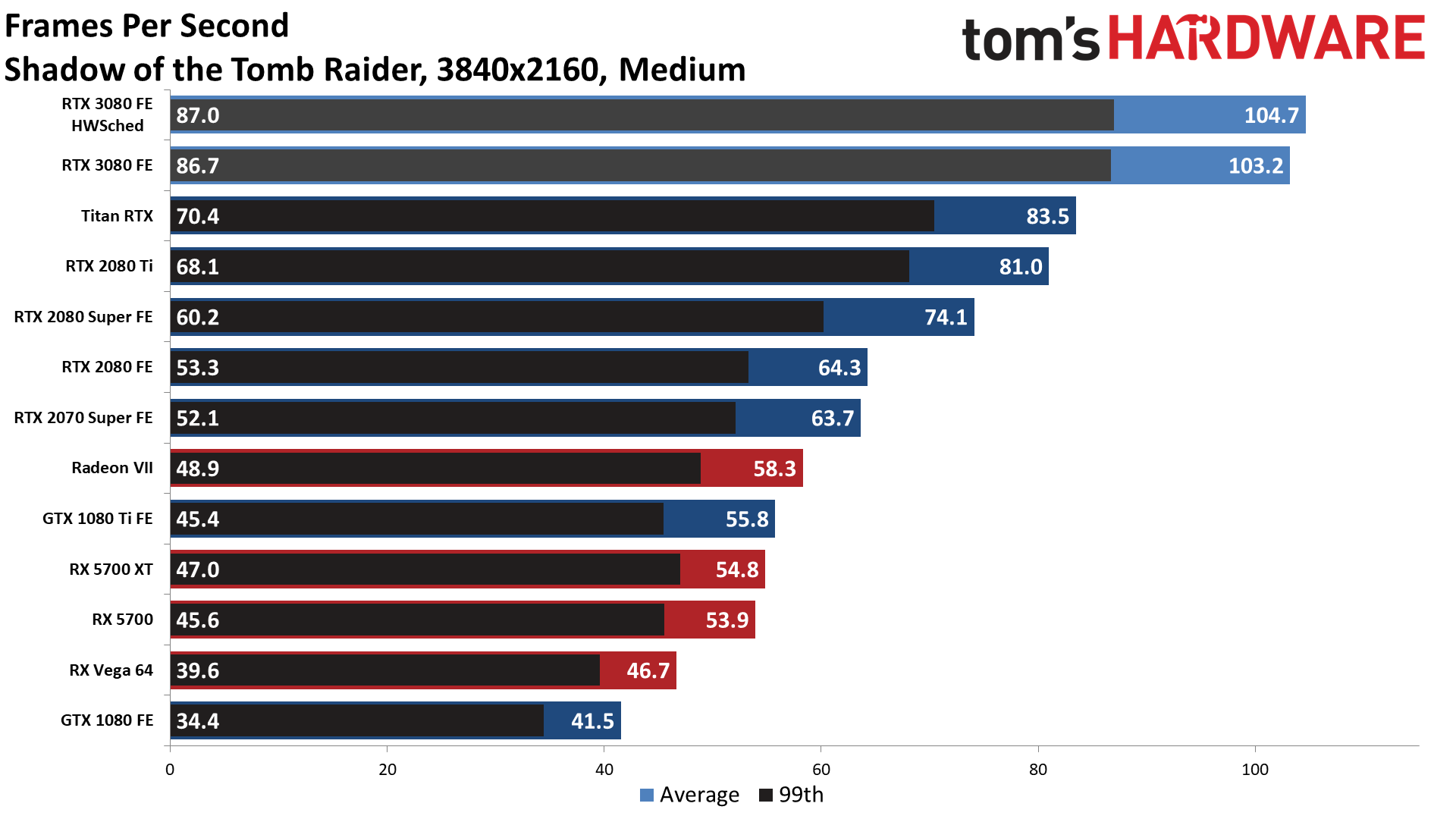

Shadow of the Tomb Raider is slightly less demanding than our overall average game, at least without ray-traced shadows enabled. Like all of the other ray tracing games right now, it was also promoted by Nvidia. It's also due for replacement (I'm looking at Watch Dogs: Legion and Cyberpunk 2077 as new alternatives), but in the meantime, we saw another 65% lead over the previous generation RTX 2080, and slightly more than double the performance of the RX 5700 XT.
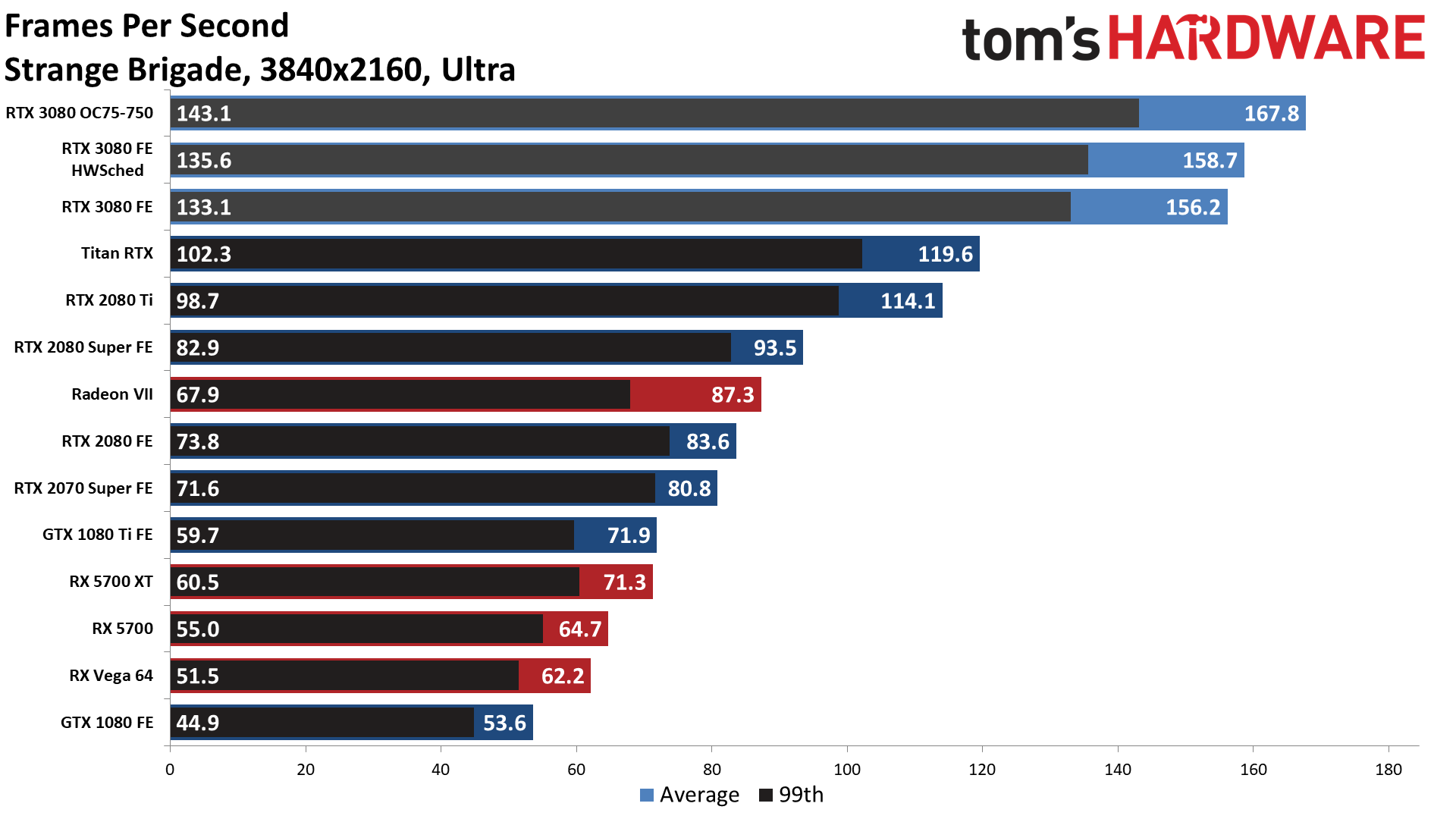
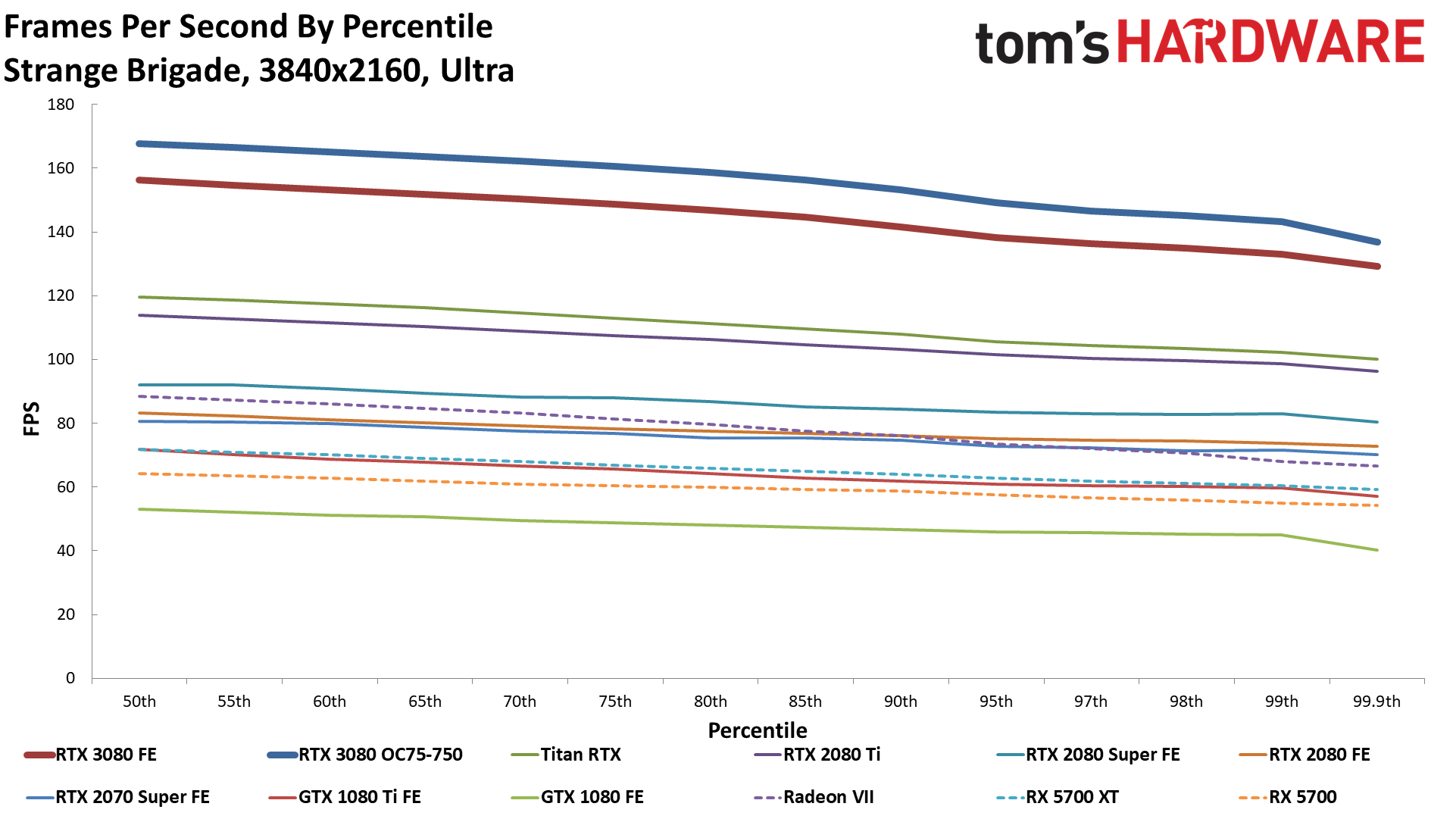
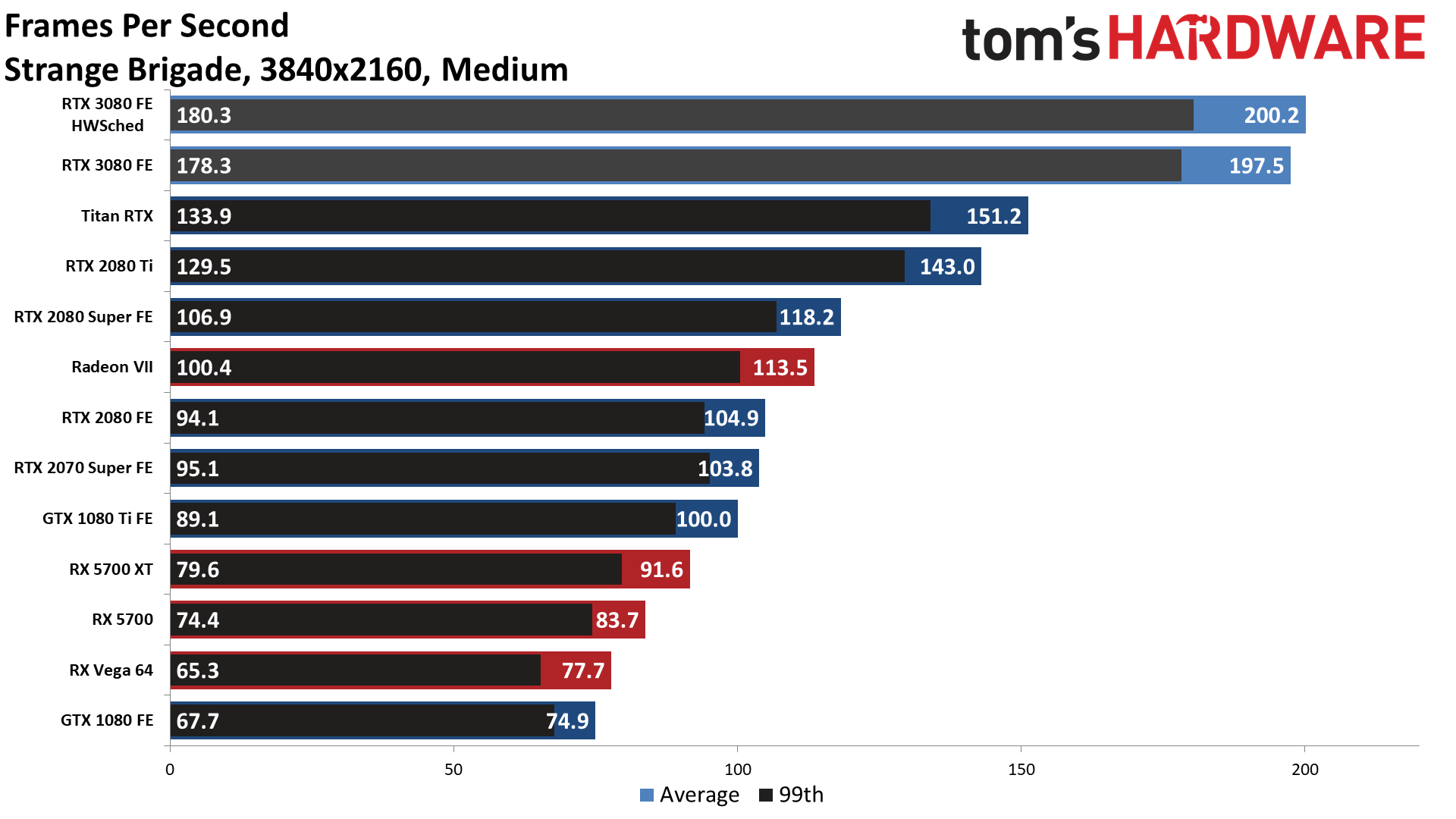
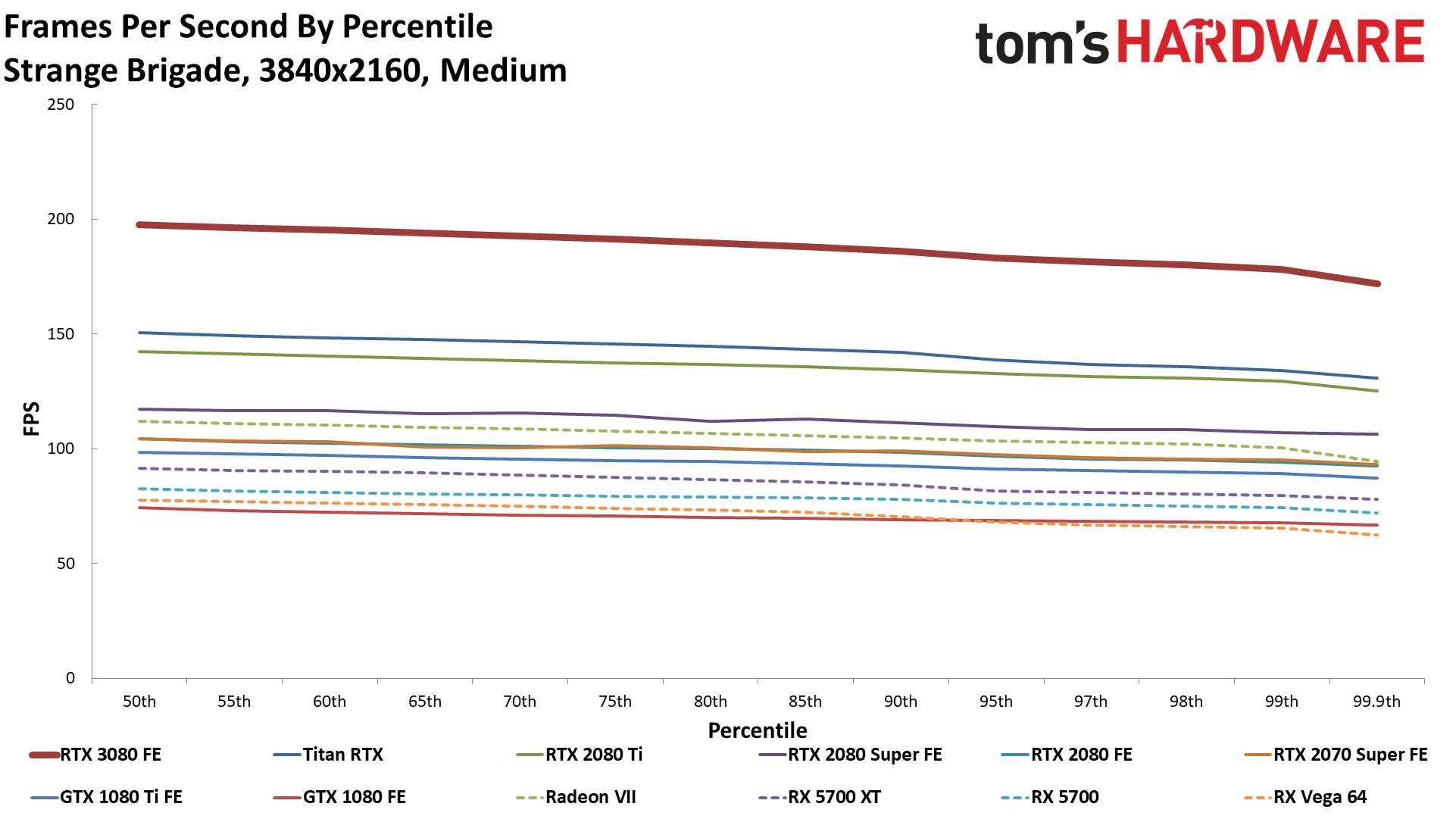
Last in our list, we have Strange Brigade, which is the only game in our primary test suite that uses the Vulkan API. It's another AMD promotional title, so if you're keeping score, our current test suite is slightly AMD slanted (four AMD, three Nvidia). Strange Brigade also manages to hit the highest framerates of any of the games we tested, perhaps thanks to the Vulkan API. Even at maxed-out settings, the RTX 3080 hit 156 fps and outperformed the RTX 2080 by 87%. It's not a game that favors AMD GPUs either, as the 3080 got its largest lead (119%) over the RX 5700 XT. Dropping the quality to medium doesn't really change things much either — this is simply a game that tends to be GPU limited even at lower settings.
Current page: GeForce RTX 3080: Sweeping the 4K Gaming Benchmarks
Prev Page GeForce RTX 3080: Initial Overclocking Results Next Page GeForce RTX 3080: 1440p Gaming Benchmarks
Jarred Walton is a senior editor at Tom's Hardware focusing on everything GPU. He has been working as a tech journalist since 2004, writing for AnandTech, Maximum PC, and PC Gamer. From the first S3 Virge '3D decelerators' to today's GPUs, Jarred keeps up with all the latest graphics trends and is the one to ask about game performance.
-
chickenballs I thought the 3080 was released in September.Reply
Maybe it's considered a "paper-launch"
Nvidia won't like that :Dchalabam said:This article lacks a tensorflow benchmark -
JarredWaltonGPU Reply
FYI, it's the same review that we posted at the launch, just reformatted and paginated now. If I wasn't on break for the holidays, I'd maybe do a bunch of new charts, but I've got other things I'll be doing in that area soon enough.Zeecoder said:This article is outdated. -
MagicPants I still think the shortage is the big news for the 3080.Reply
I might be paranoid, but I think there be something to the fact that the top ebay 3080 scalper "occomputerparts" has sold 97 RTX 3080s from EVGA specifically and shipped them from Brea, California.
Anyone want to guess where EVGA is headquartered??? Brea, California.
Now it could be that some scalper wrote a bot and has been buying them off Amazon, BestBuy, and Newegg. But then why only sell EVGA cards? They'd have to program their bot to ignore cards from other vendors, which wouldn't make any sense. -
TEAMSWITCHER ReplyMagicPants said:I still think the shortage is the big news for the 3080.
I might be paranoid, but I think there be something to the fact that the top ebay 3080 scalper "occomputerparts" has sold 97 RTX 3080s from EVGA specifically and shipped them from Brea, California.
Anyone want to guess where EVGA is headquartered??? Brea, California.
Now it could be that some scalper wrote a bot and has been buying them off Amazon, BestBuy, and Newegg. But then why only sell EVGA cards? They'd have to program their bot to ignore cards from other vendors, which wouldn't make any sense.
It's probably an inside job. Demand for RTX 3000 series is off the charts! I don't see any good reason to buy an AMD GPU other than for a pity-purchase. AMD is pricing their cards less, because they are less. In sheer performance it's just a bit less, but in next generation capabilities .. it's a lot less. I will hold out for an RTX 3080. AMD won't catch up, before Nvidia has filled the demand of the market. Patience will be rewarded. -
LeszekSol What is a point discussing items (namely - Nvidia RTX3080 Founders Edition) which dos not exist in free market? Cards are anavailable since first day of "hiting market" and even Nvidia has no idea (or perhaps plans) when it will become available again. There are other cards based on similar architecture - but actually a little different - so.... WHAT FOR guys you are loosing time to discuss this? Lets forget about NVidia, or let's put it on the shelf with MobyDick books.....Reply -
PureMist Hello,Reply
I have a question about the settings used in the testing for FFXIV. The chart says Medium or Ultra but the game itself only has Maximum and two PC and Laptop settings. So how do these correlate to the actual in game settings? Or are “Medium” and “Ultra” two custom presets you made for testing purposes?
Thank you for your time. -
JarredWaltonGPU Reply
Sorry, my chart generation script defaults to "medium" and "ultra" and I didn't think about this particular game. You're right, the actual settings are different in FFXIV Benchmark. I use the "high" and "maximum" settings instead of medium/ultra for that test. I'll see about updating the script to put in the correct names, though I intend to drop the FFXIV benchmark at some point regardless.PureMist said:Hello,
I have a question about the settings used in the testing for FFXIV. The chart says Medium or Ultra but the game itself only has Maximum and two PC and Laptop settings. So how do these correlate to the actual in game settings? Or are “Medium” and “Ultra” two custom presets you made for testing purposes?
Thank you for your time. -
acsmith1972 The cheapest I see this card for right now is $1800. I really wish these manufacturers wouldn't be pricing these cards based on bitcoin mining. It's once again going to price the rest of us out of getting any decent video cards till BTC drops again.Reply
